We have already presented Krakow to you in detail in a separate article with its most beautiful sights (click here for our practical Krakow tips). Today we take you to a parallel world of about 200,000 inhabitants, which has nothing to do with the magnificent buildings in the center. In Nowa Huta (English: New Steelworks), an ideal communist city was created after the Second World War, in which time seems to have stood still. So it’s high time to introduce Nowa Huta Krakow to you in more detail.
This is Nowa Huta in Krakow – The history of the district
The “New Human” often praised in socialism was to be given a “New Home” in Nowa Huta after the Second World War. The leadership of communist Poland decided to locate an ironworks combine here, where thousands of people found work.
The location of Nowa Huta was deliberately chosen. Although a site in the Upper Silesian industrial district, which was dominated by heavy industry, would have made more sense, the Polish Communists wanted to set a deliberate counterpoint to bourgeois, intellectual Krakow, the city of Polish kings.
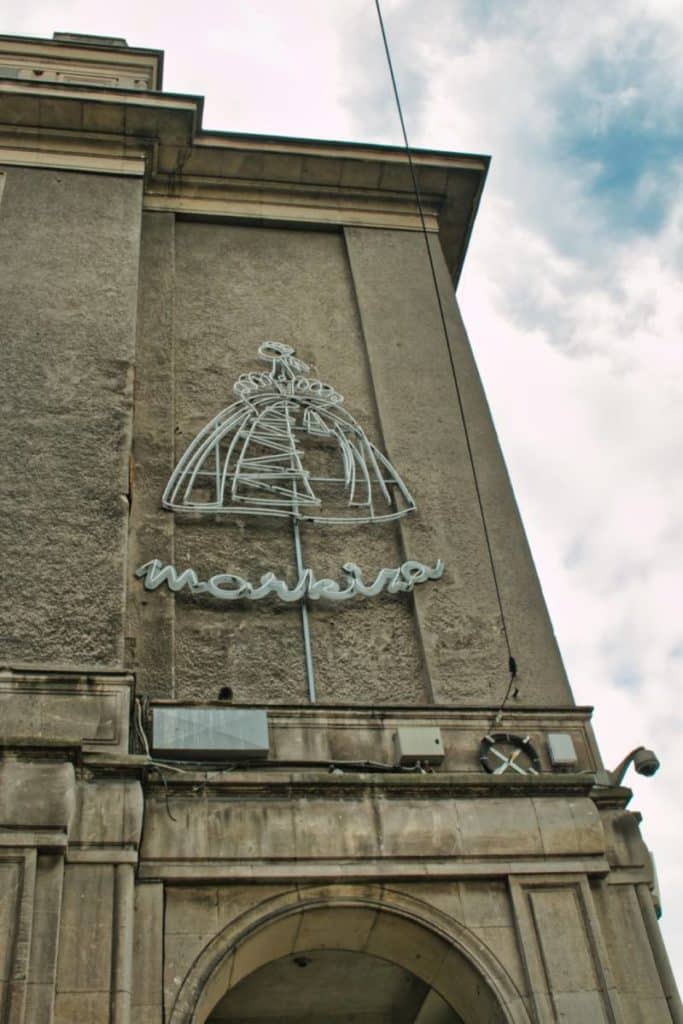
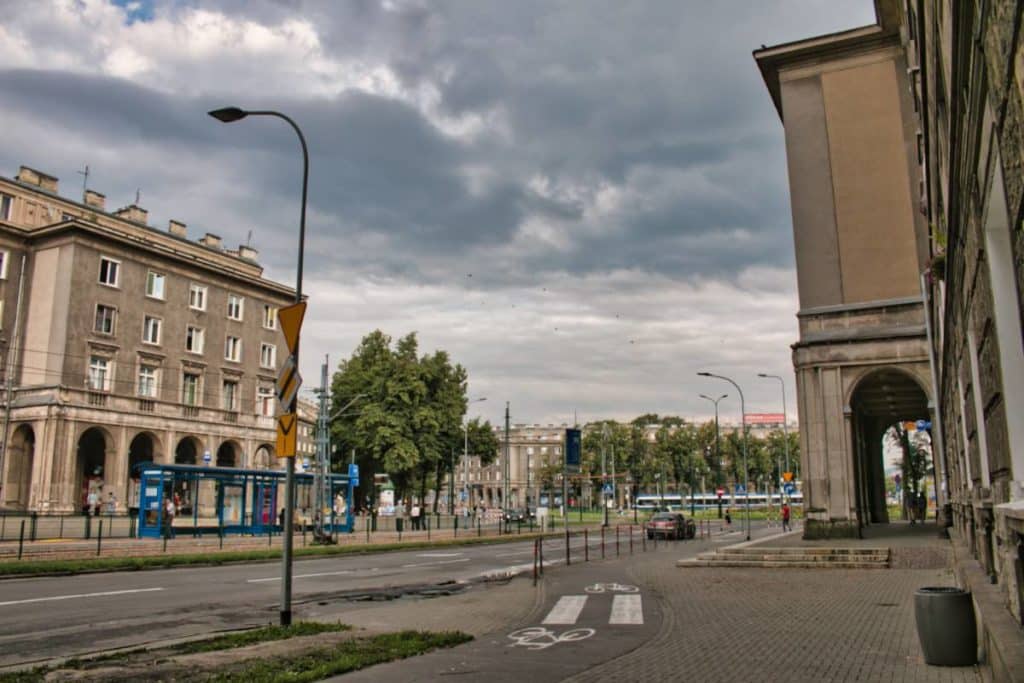
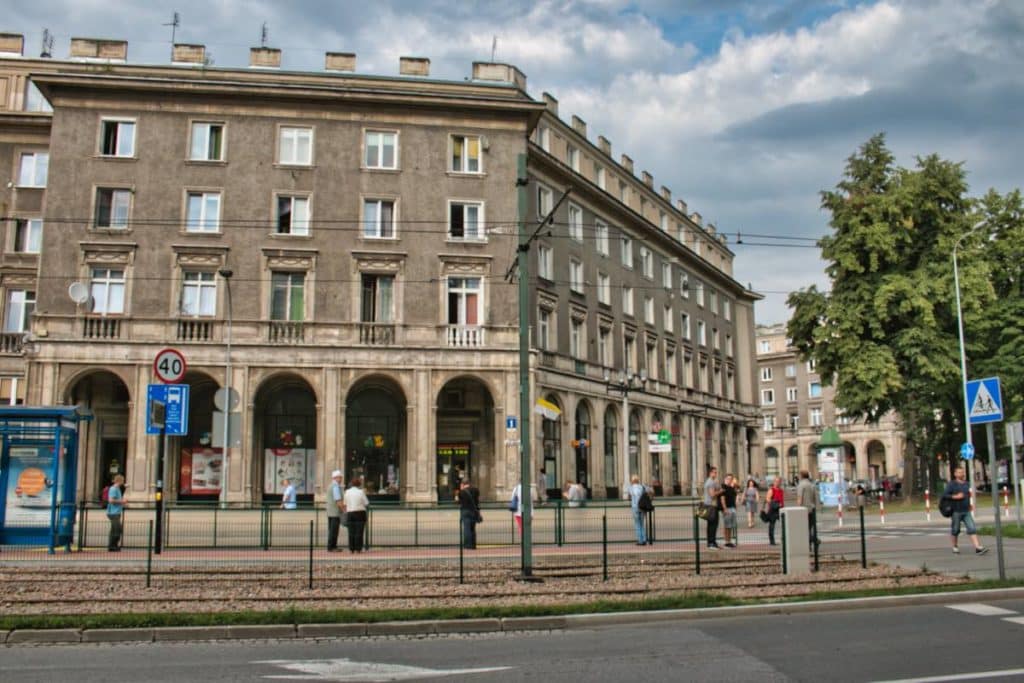
Lenin or Reagan?
As early as 1951, the previously independent town of Krakow was incorporated. In only about five years, a whole series of buildings were erected, which certainly do not meet every taste, but are an impressive testimony to socialist urban planning. In Catholic Poland, no church was deliberately planned for the “New Human”. A project that ultimately failed due to the resistance of the population, but more on that later.
The center of Nowa Huta was and is Lenin Square, whose name today – not entirely free of historical irony – bears Ronald Reagan’s name. It is built like a sun and from it depart in a semicircle the “rays”, that is, the wide avenues of splendor that form several plots and in turn have symmetrically arranged side streets.
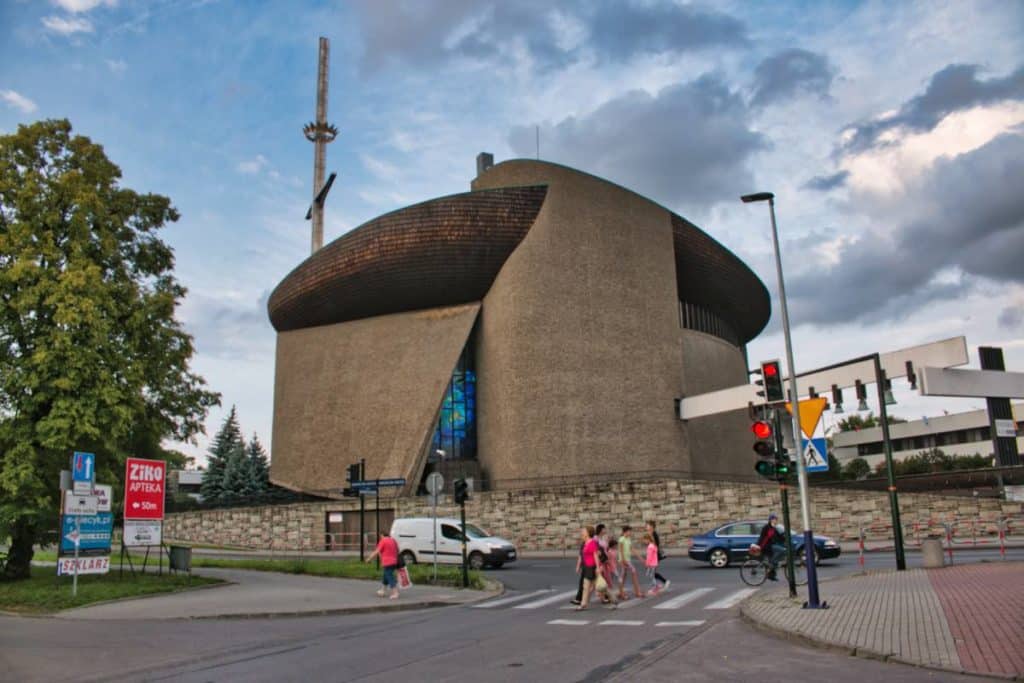
Fight for crosses and places of worship
Although the apartments, which were very modern by the standards of the time, offered all the necessary comforts and the residents, most of whom were recruited from the poor rural population, received them positively, the lack of churches quickly caused resentment among them. Things were also quite chaotic here in the early years. Corruption and crime characterized the first years of Nowa Huta. Therefore, during the thaw period, the rulers reluctantly decided to hold a competition to build a church. This did not happen, however, because a school was built instead, which created a potentially dangerous atmosphere for the government.
The following years were marked by the struggle for the erection of a cross, in which Karol Wojtyła, Archbishop of Krakow and later Pope John Paul II, also played a part. Bloody clashes ensued. In the end, the government had to give in and allow the construction of a church, the spectacular “Ark of the Lord”.
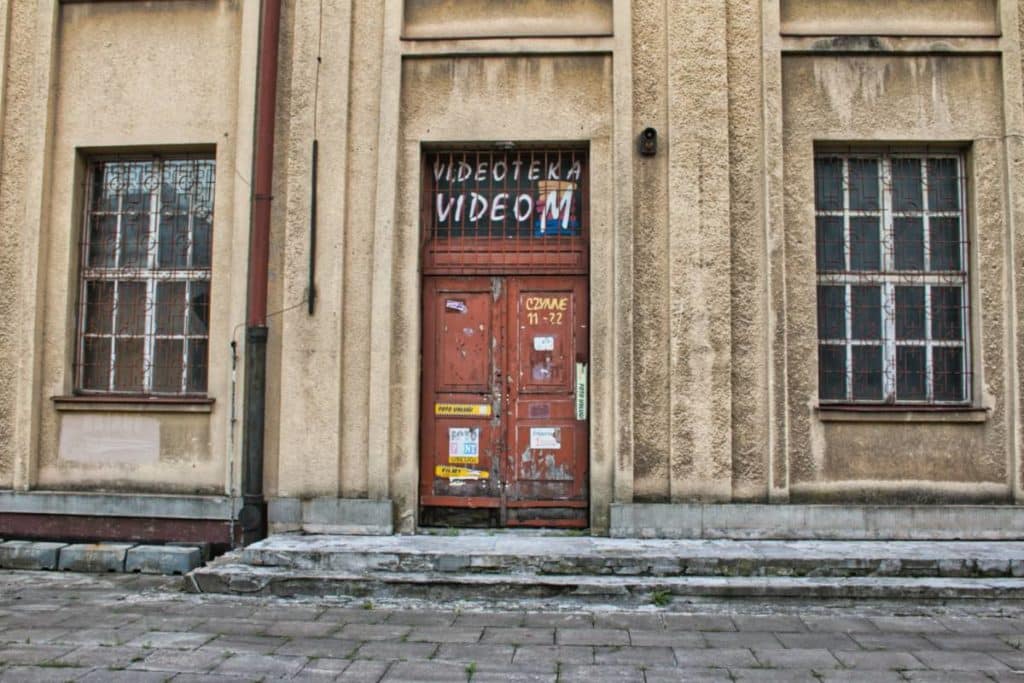
Short boom phase and dreary recent past
While the 1970s were still characterized by a boom in the steel industry (just as the country as a whole experienced relative prosperity during this period, although this was also due to a high level of foreign debt), the rise of the Solidarność movement was paralleled by Nowa Huta’s economic decline, which lasted until the 1990s. In the meantime, however, the city within the city has consolidated. Although Nowa Huta still enjoys a comparatively poor reputation among Krakow residents, according to statistics it is the safest district in the entire city. Since many buildings are now listed, you can enjoy a walk around the city today that is unique in all of Poland.
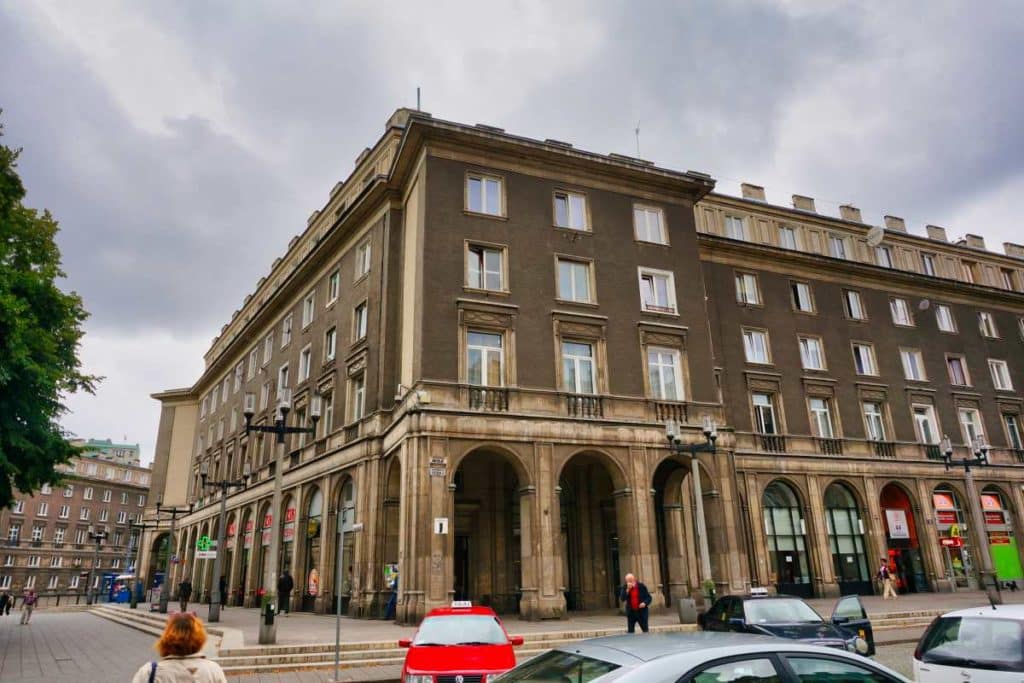
Ronald Reagan Square
Let’s start our walk at Lenin Square, which today bears Ronald Reagan’s name and is often called Central Square. You can easily reach it from the center of Krakow by streetcar 4, 10 or 22, which goes along John Paul II Avenue and used to be called the Street of the Six-Year Plan. The square is the center of the “sun” of Nowa Huta, towards which at an angle of 45° run five rays of the sun, the wide avenues that parcel Nowa Huta.
A, B, C and D
Apparently, no great effort was made in naming these plots, because they simply bear the names of the first four letters of the alphabet. But one can see very well from this what Nowa Huta was all about: a combination of functionality, control and propaganda. The wide square was not only a parade ground, but could also be guarded very well.
Famous architects
Tadeusz Ptaszycki was commissioned with the planning of this so important square. The architect, who was born in St. Petersburg, had already participated in several projects in Wroclaw and had pushed the reconstruction of the completely destroyed city, which made him the ideal choice for the design of Nowa Huta. He was also involved in several projects in other cities. His career came to an abrupt end when compromising documents were foisted on him, thus removing him from all offices in the late 1960s.
Marta and Janusz Ingarden were entrusted with the design of the houses. Ingarden, a native of Torun, was less than 30 years old at the time and, together with his wife, subsequently left his architectural mark on Nowa Huta like no other. The couple is also interesting because they recognized the signs of the times in the 1960s and created modernist buildings, which you can still find today in Nowa Huta and Krakow.
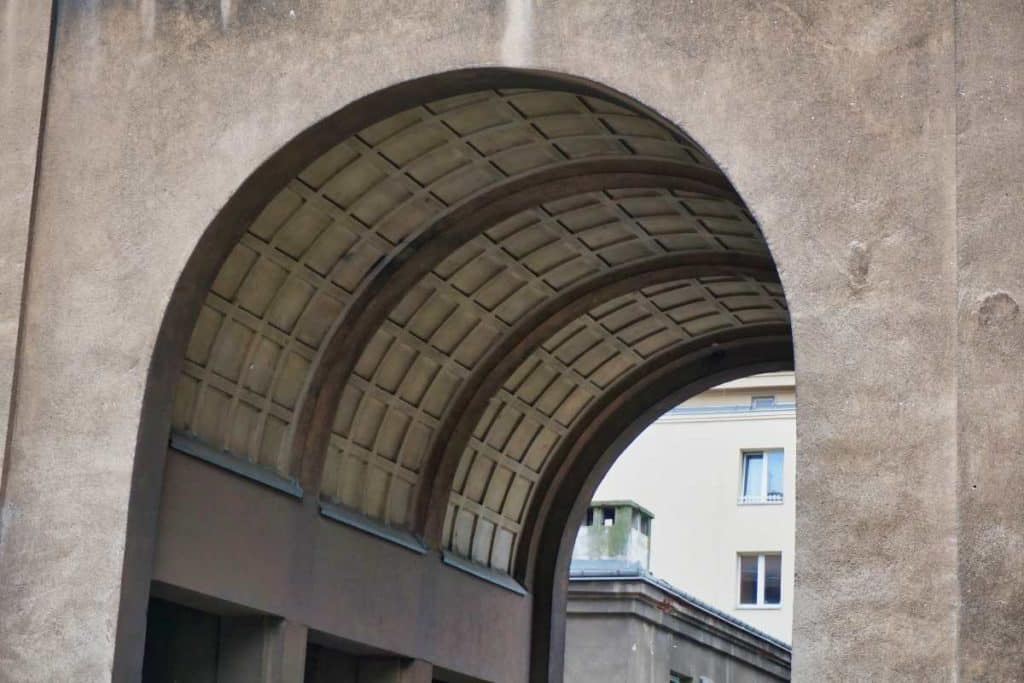
The design of the buildings
When you stand on the old Lenin Square, the first thing you might think is: Oh man, quite gray here. And indeed, dark brown and gray tones dominate the picture. The buildings of Socialist Realism were supposed to be monumental and intimidating. Yet they are not without finesse in design and, as elsewhere, often draw on local building traditions. Old Krakow is characterized above all by its Renaissance buildings, and this is precisely what was drawn upon here. Coffered ceilings, superstructures on the houses, reminiscent of the famous cloth halls on the market square and many other details create a somewhat gray, but still impressive and harmonious-looking overall picture.
Shopping in a unique ambience
The buildings on the square – and many others in the neighborhood – were designed in such a way that there were stores, cafés and craftsmen’s workshops below and the living quarters for the workers on the upper floors. This was not only practical, but also in keeping with local traditions, as merchants in the marketplace in the center of Krakow already lived and worked this way in the Middle Ages. Our tip: Go to the store Cepelix in the corner house on the right. Here you can not only admire the original interior with its wooden counters and chandeliers, but could also buy handmade art and souvenirs of Nowa Huta.
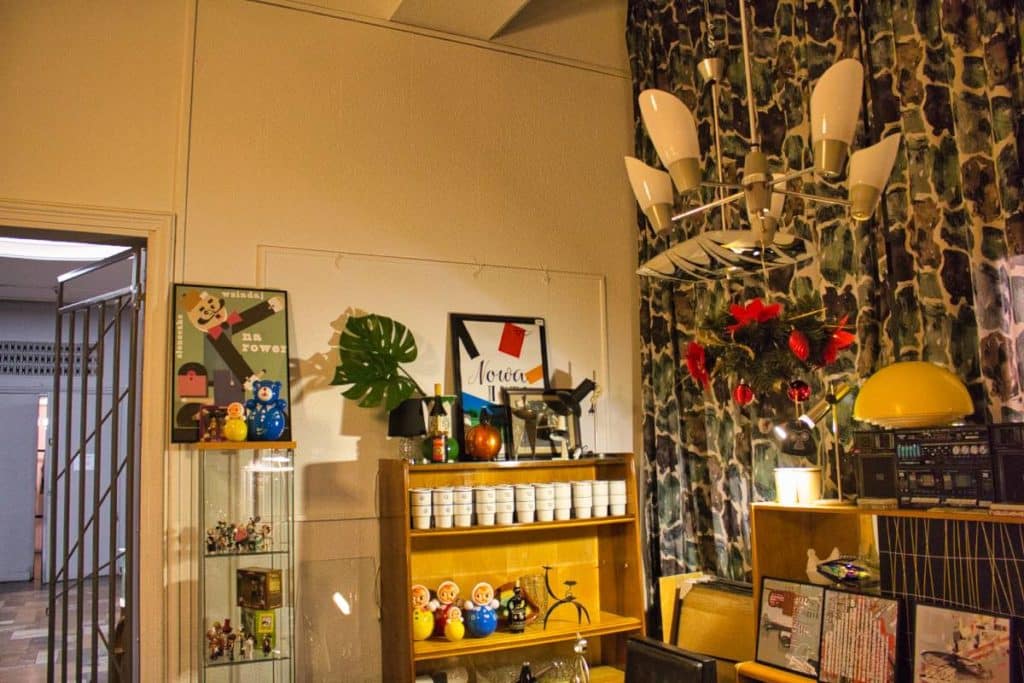
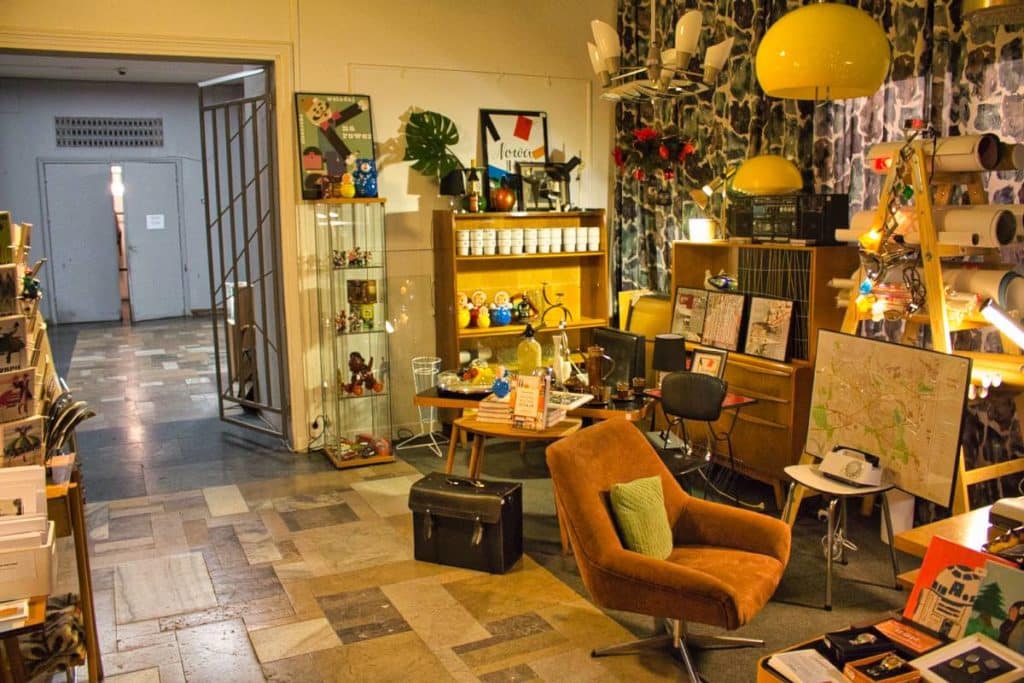

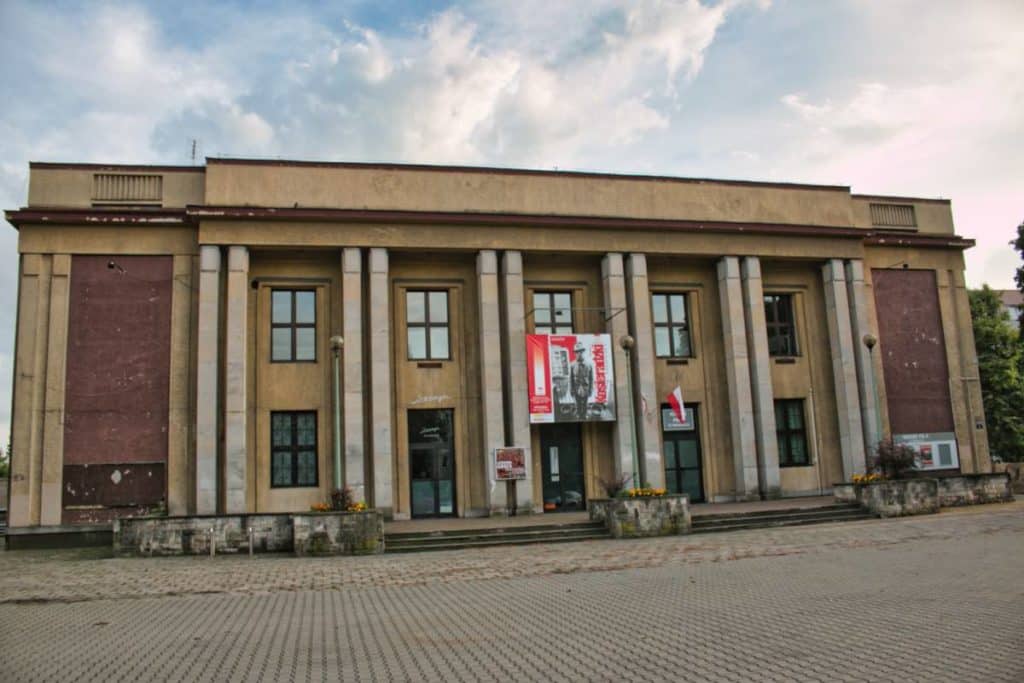
Światowid Cinema
If you stand in the middle of the square and turn right, you can follow the course of the streetcar out of town, and after about 300 meters you will come to a Lidl supermarket and then to the Światowid cinema. Under socialism, it was always important to the rulers to promote the education and culture of the workers (of course, only as long as it was in the interest of the regime). This included a cinema that soon achieved cult status and was designed by Andrzej Uniejewski. Here, too, there are echoes of antiquity. It had only two halls, one with a fancy gallery, the other with a coffered ceiling. Like many buildings in Nowa Huta, the cinema is also under-bunkered to provide protection for the population in the event of an attack by Western bombers.
Nowa Huta Museum
After the fate of the cinema was on the line for a long time, from 2013 it housed the Museum of the History of the People’s Republic of Poland, which was united with the Historical Museum of the City of Krakow in 2019. Since then, the Nowa Huta Museum has been located here. Here you can learn about the eventful history of Nowa Huta and learn many interesting details about the life of local people and about the Polish People’s Republic. In the house you can also find the Szpeje Shop, where a local dealer sells antiques from the time of the Polish People’s Republic and from the neighboring socialist countries.
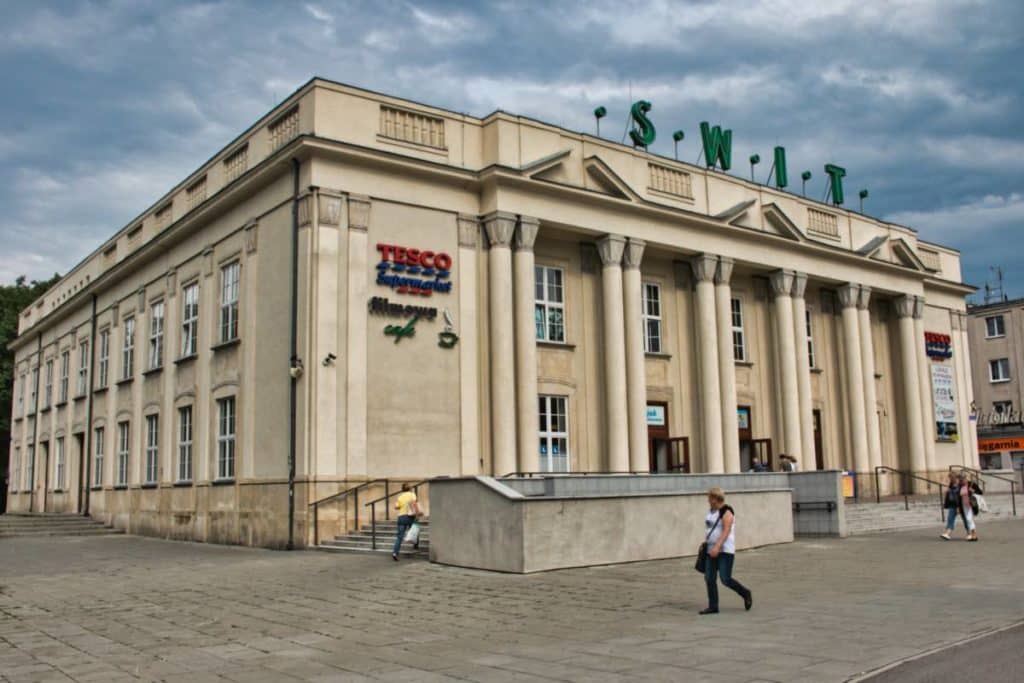
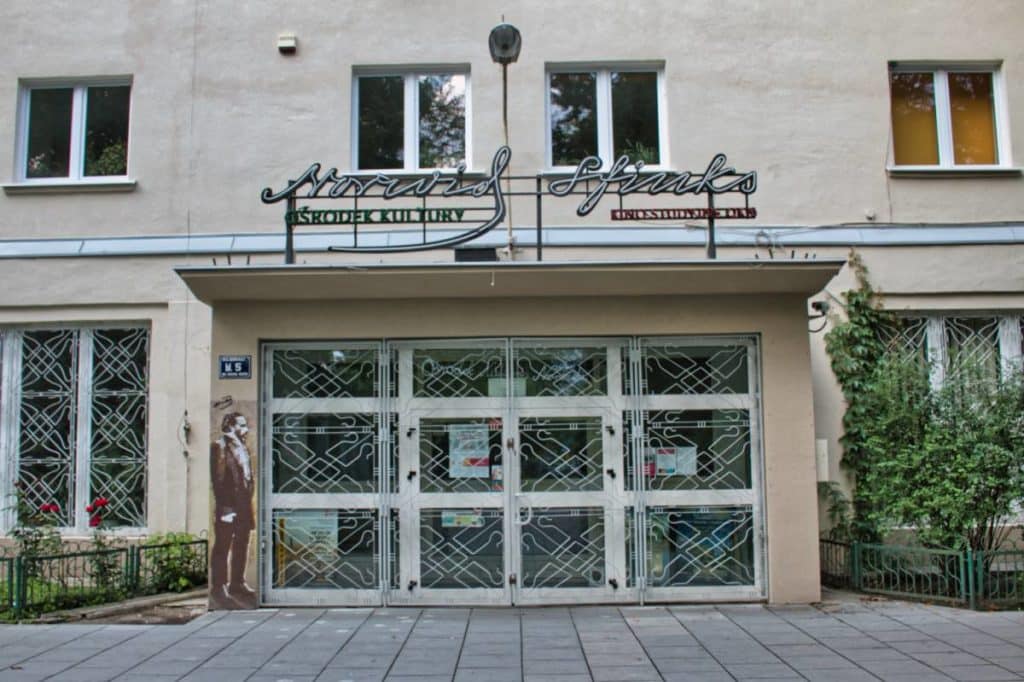
Other cinemas in Nowa Huta
The other two well-known cinemas of Nowa Huta have also been converted in the meantime. The former Świt cinema, which looks like the Światowid cinema, now houses a supermarket. The former Sfinks cinema, located near the People’s Theater, is now a cultural center where stage shows and other events take place.
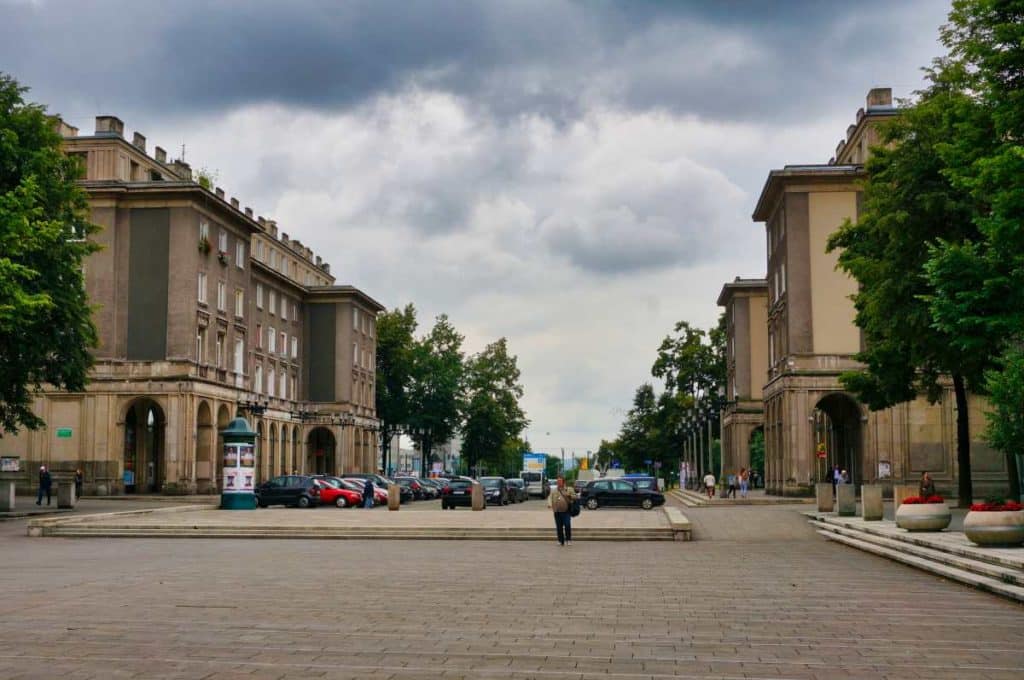
Avenue of the Roses
But enough looking around, now it’s time for a little walk. We will walk along the Avenue of the Roses, the central street of Nowa Huta. The avenue owes its beautiful name to the tubs with roses on both sides of the promenade.
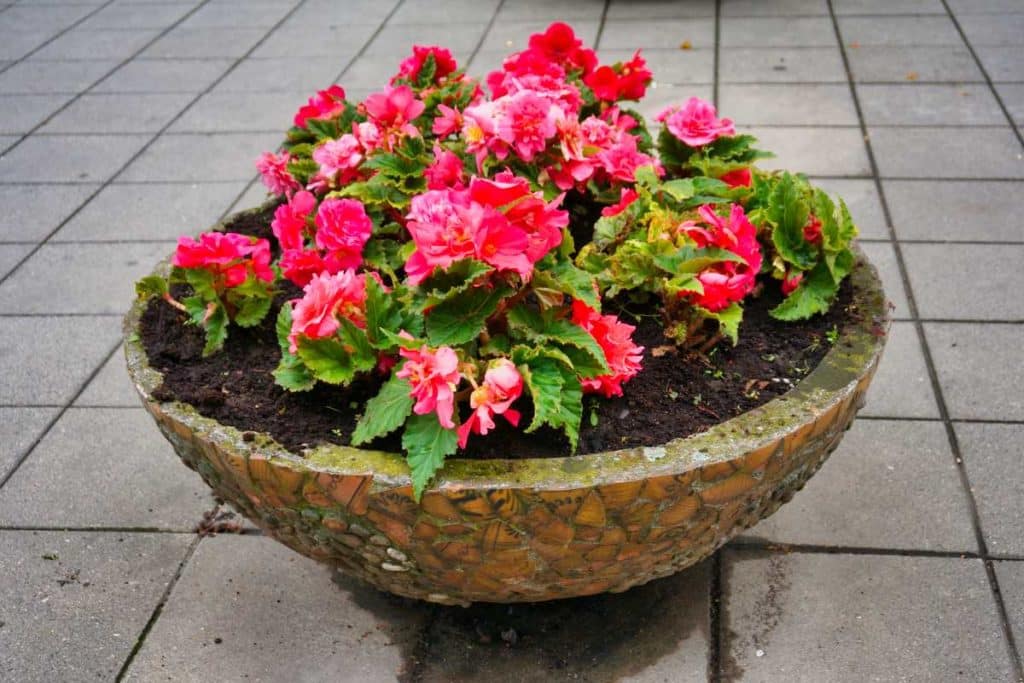
The street is about 1.5 km long and is characterized by buildings from the first construction phase of Nowa Huta, which was completed around 1955. After only a few meters the street is crossed by the Avenue of Friendship, where the town hall of Nowa Huta was supposed to stand. However, since the municipality was incorporated into Krakow while the road was still under construction, this idea was abandoned.
Lack of statues and money
A bit to the north stood a huge statue of Lenin from 1973, which shared the fate of so many Lenin statues in the country and was taken down after the fall of communism. In this area you can already see that the buildings are somewhat less decorated than those at Reagan or Lenin Square. This is due to the fact that the street was built up piece by piece towards the north. Due to lack of money, however, it was decided in the course of the 1950s to save on the decoration.
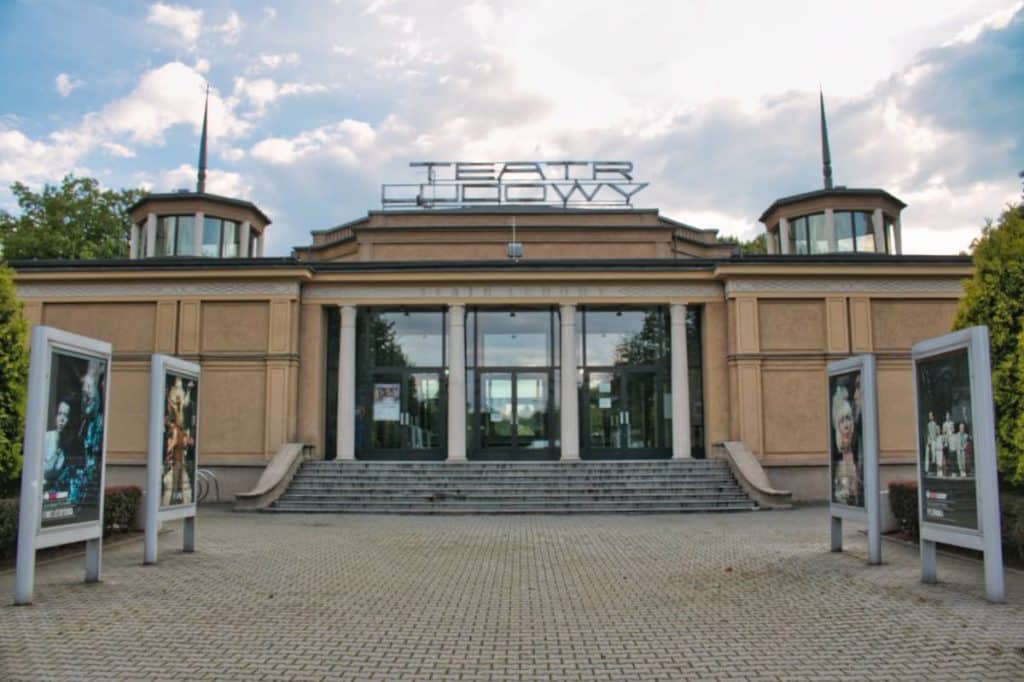
Theater of the People
Northwest of Rosenallee stands the Theater of the People. One of the most important cultural institutions of the district was built between 1950 and 1953, the Theater of the People (Teatr Ludowy). Several architects were responsible for the building, including the Ingarden spouses. The rectangular building has three flat tower tops and two rotundas with a pointed needle to the left and right of the entrance. Several ancient elements were picked up here, which can be seen on the outside in the columns and pilasters and on the inside in the shape of an amphitheater. For us, one of the most exciting buildings in all of Nowa Huta!
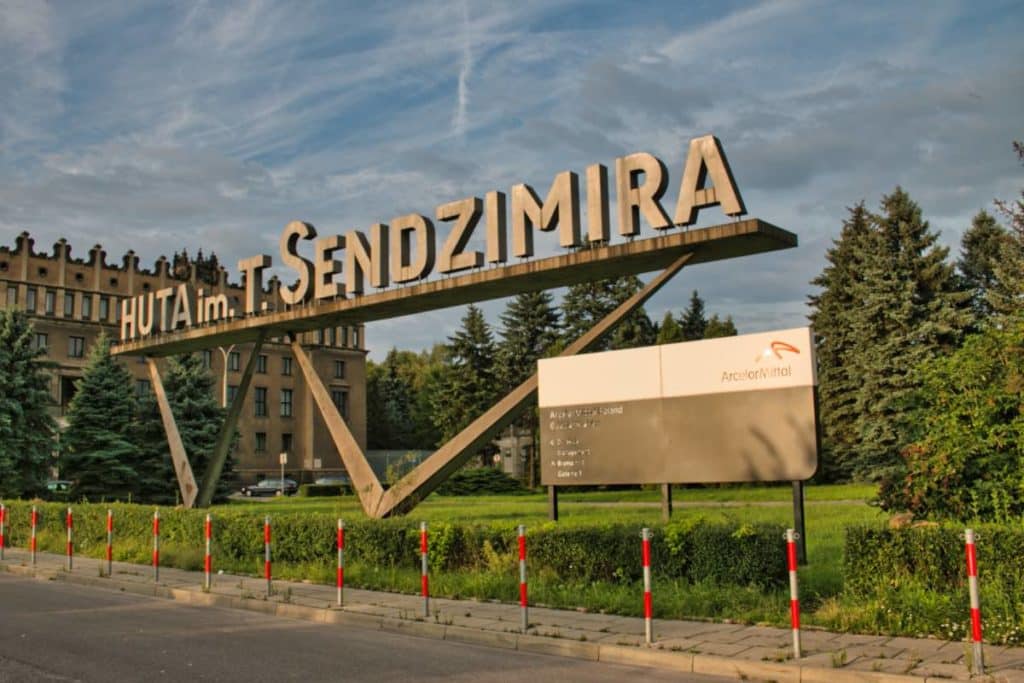
Lenin Combinate
Now we return to Lenin Square. With all the interesting buildings, it’s easy to forget why the district was actually built. The Lenin Combinate was the place where many of the district’s residents found work. At peak times, there were 40,000 people on duty here! Six million tons of steel were produced here every year, and the plant is many times larger than Krakow’s Old Town. What has become an iconic landmark of Nowa Huta is the metal lettering at the beginning of the site, which used to bear Lenin’s name. Today, the steelworks is named after Tadeusz Sendzimir, a Polish engineer originally from Lviv. With over 120 patents registered, he was one of the most important metallurgists of the 20th century.
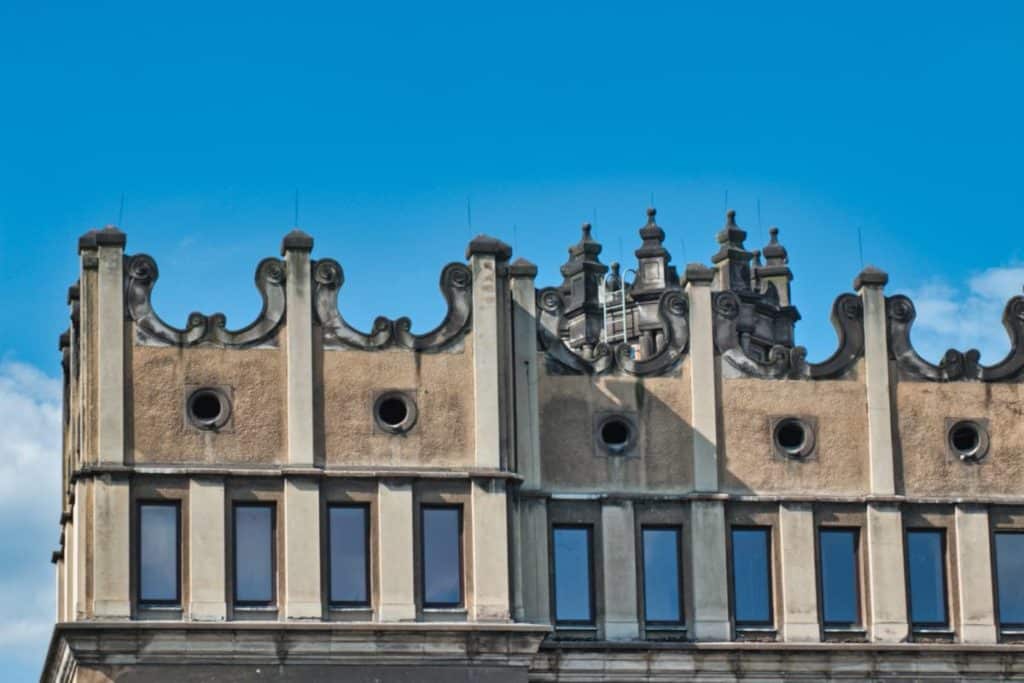
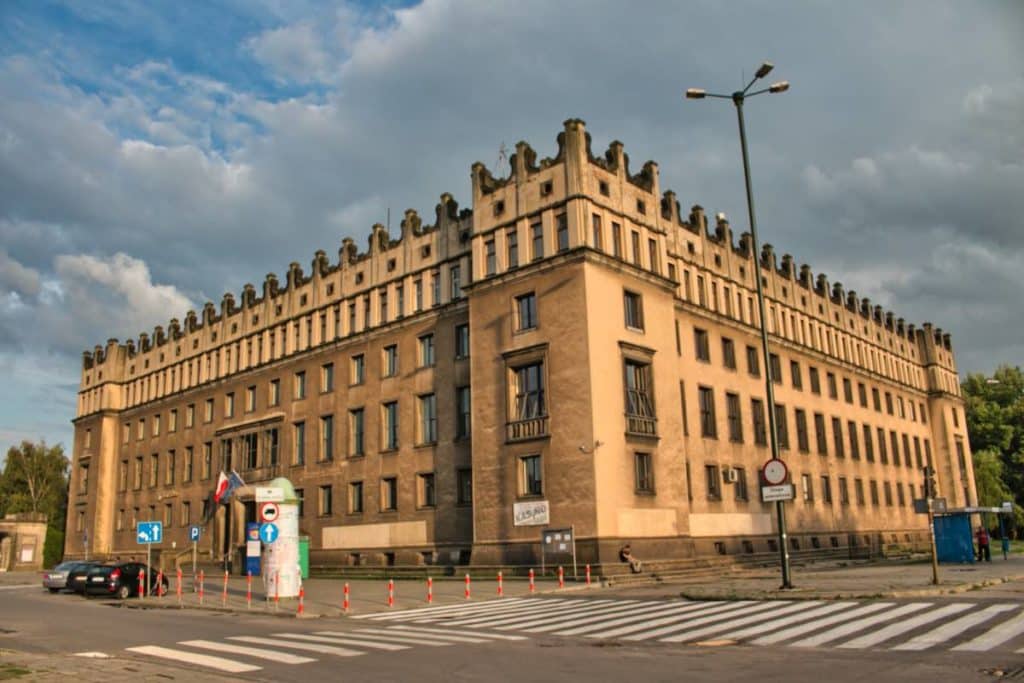
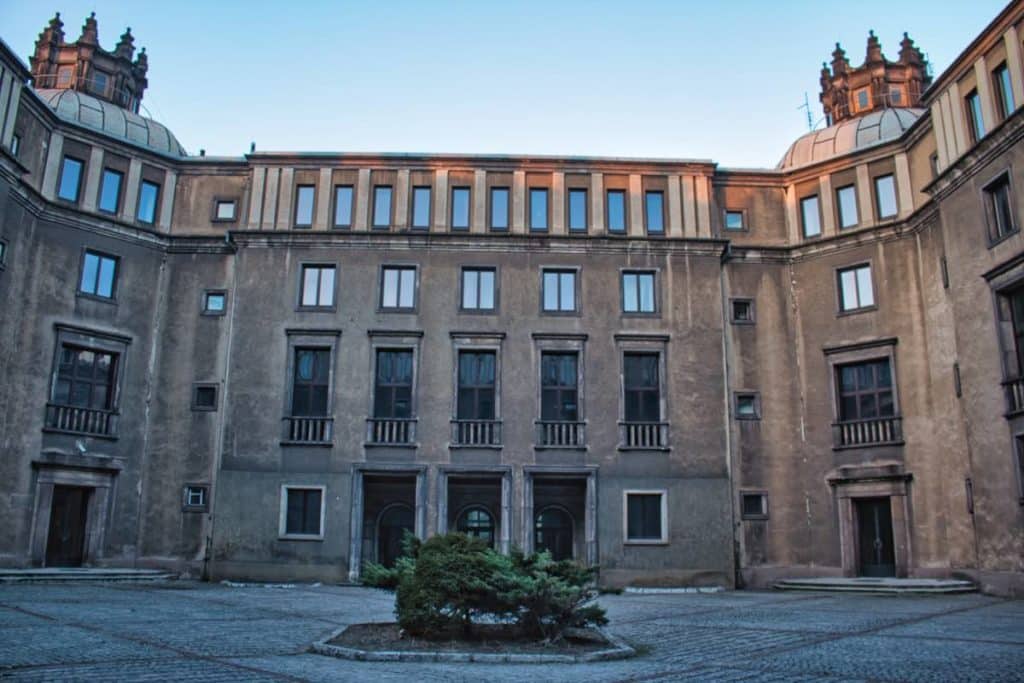
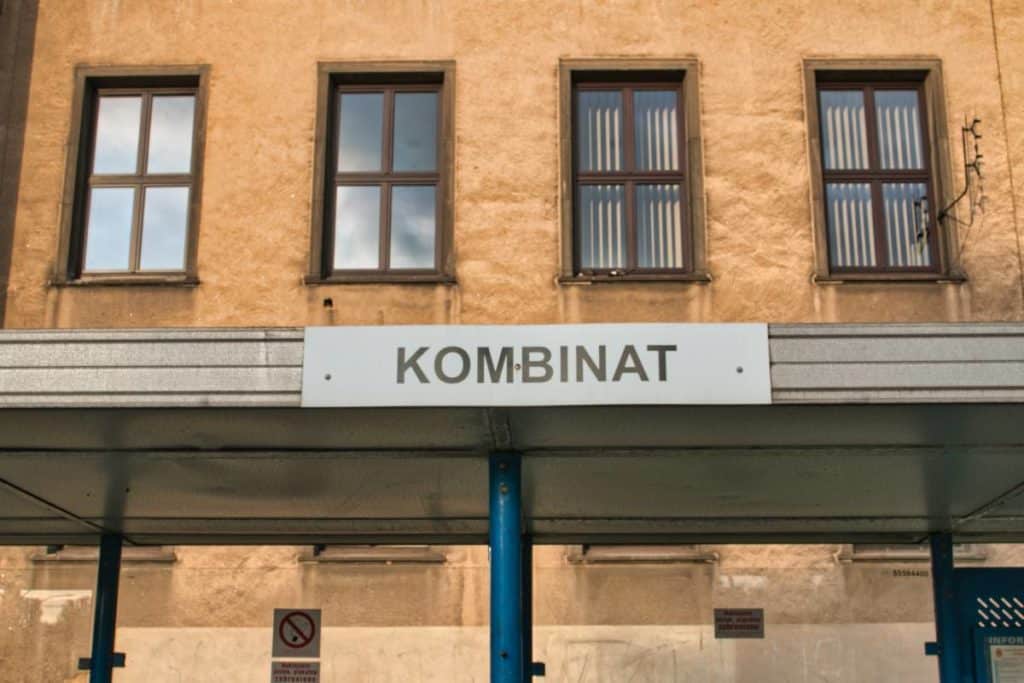
Administrative center S/Z
Besides the Sendzimir lettering, two huge buildings catch the eye. They stand on both sides of the entrance to the plant site and are identical in construction. With their four corner towers, they look a bit like old castles. Marta and Janusz Ingarden were also responsible for this, and they also called Janusz Ballenstedt on board. With the attics and the domes under the towers, which are said to be reminiscent of Michelangelo’s work, they are also among the most exciting buildings in Nowa Huta Krakow. For administrative buildings, they have many other lovingly designed details such as coffered ceilings and curved wooden spiral staircases.
Turning away from Socialist Classicism
The thaw period also had a massive impact on the design of Nowa Huta from the mid-1950s. Thus, mainly buildings in the style of modernism were now created, which were strongly influenced by the West and produced many exciting buildings.
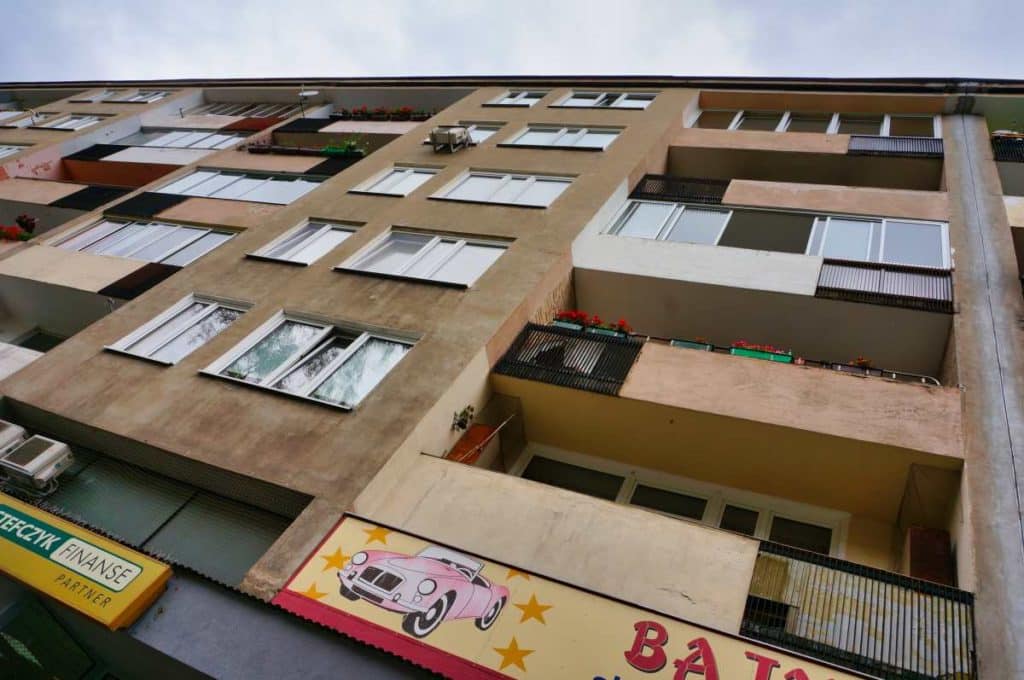
Swedish block
The so-called Swedish Block was another project of Marta and Janusz Ingarden. The building is a good example of how the Ingardens made the leap into modernity and how this style icon was realized between 1956 and 1959.
With over 200 meters, the Swedish Block is the longest building in Nowa Huta. But where did the building get its strange name? Concrete produced under Swedish license was used in its construction. But besides all the concrete, the apartment block is a real eye-catcher mainly because of its many windows and balconies. Downstairs on the first floor there are several stores and workshops. This structural unity of living and working became exemplary for the whole of Poland and dominated the socialist prefabricated buildings of the following decades.
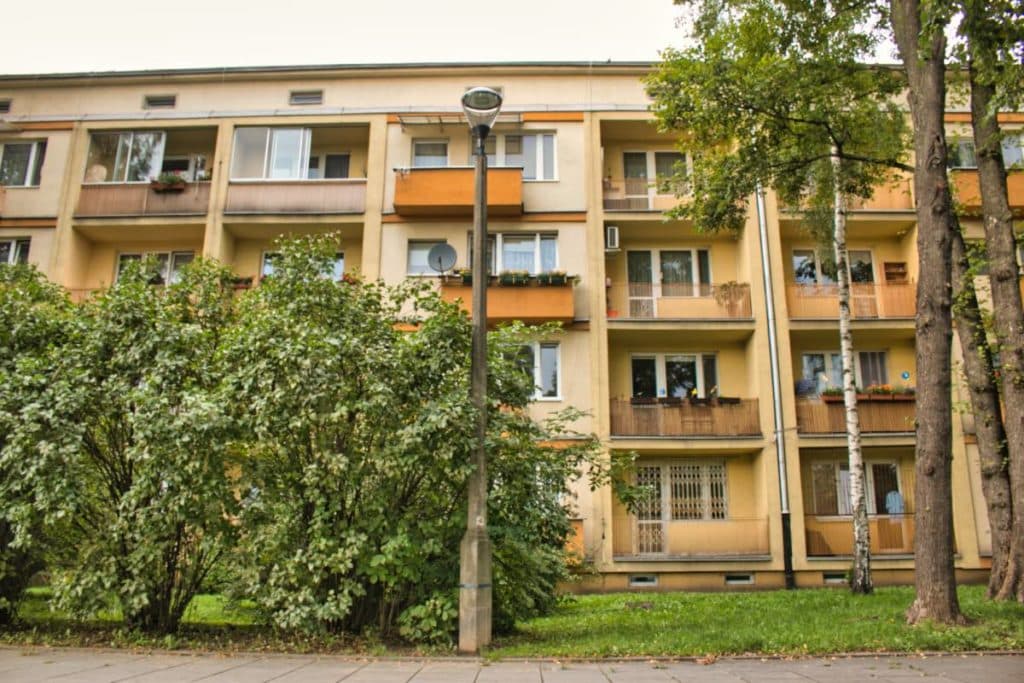
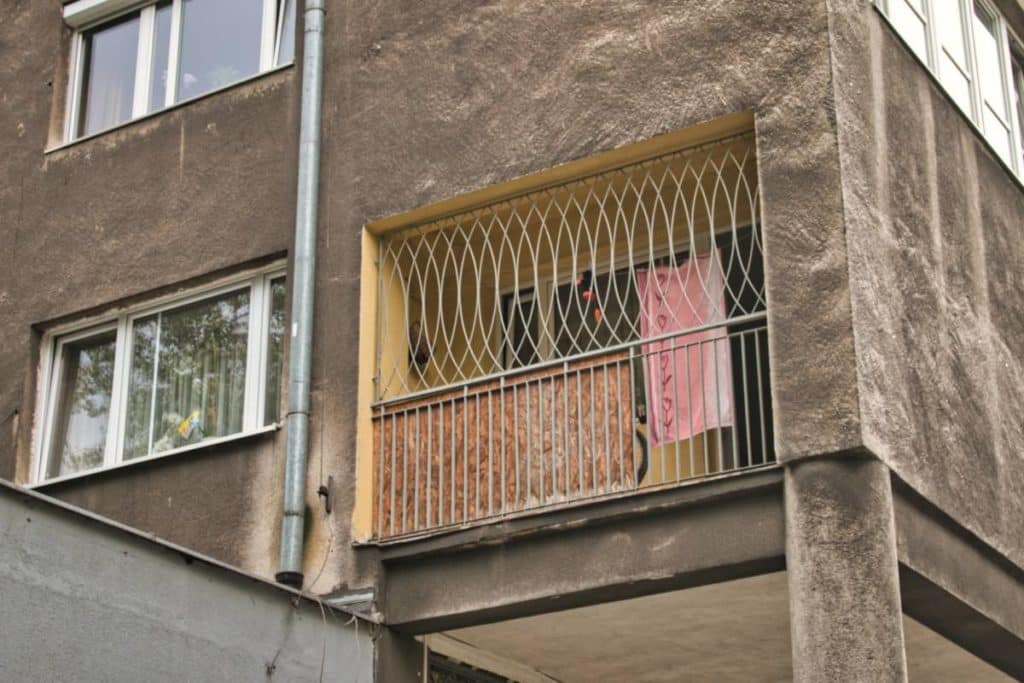
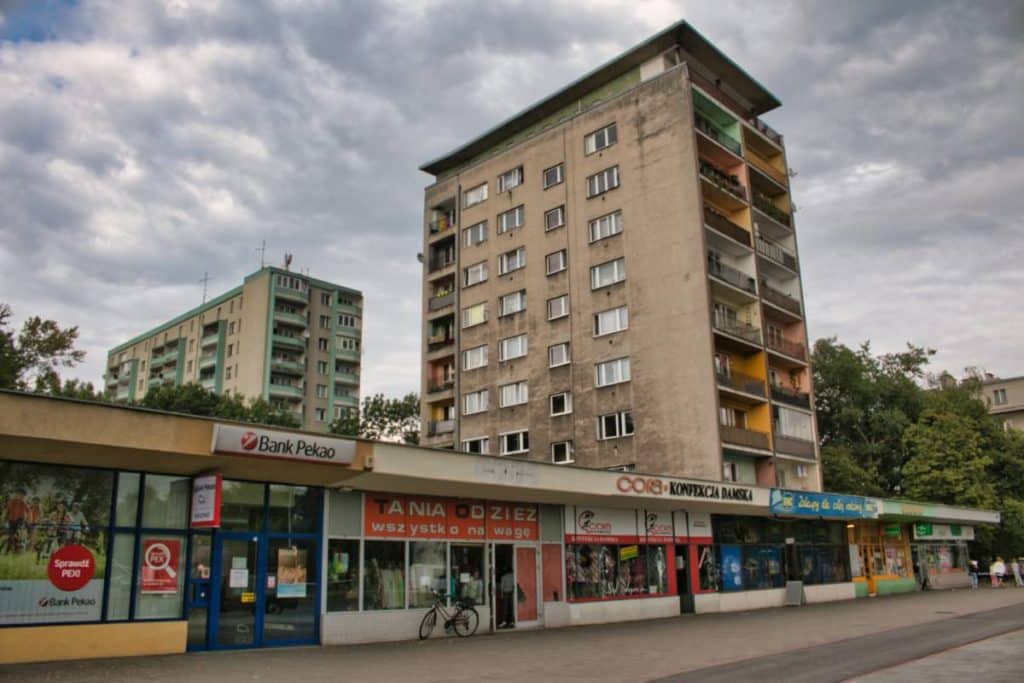
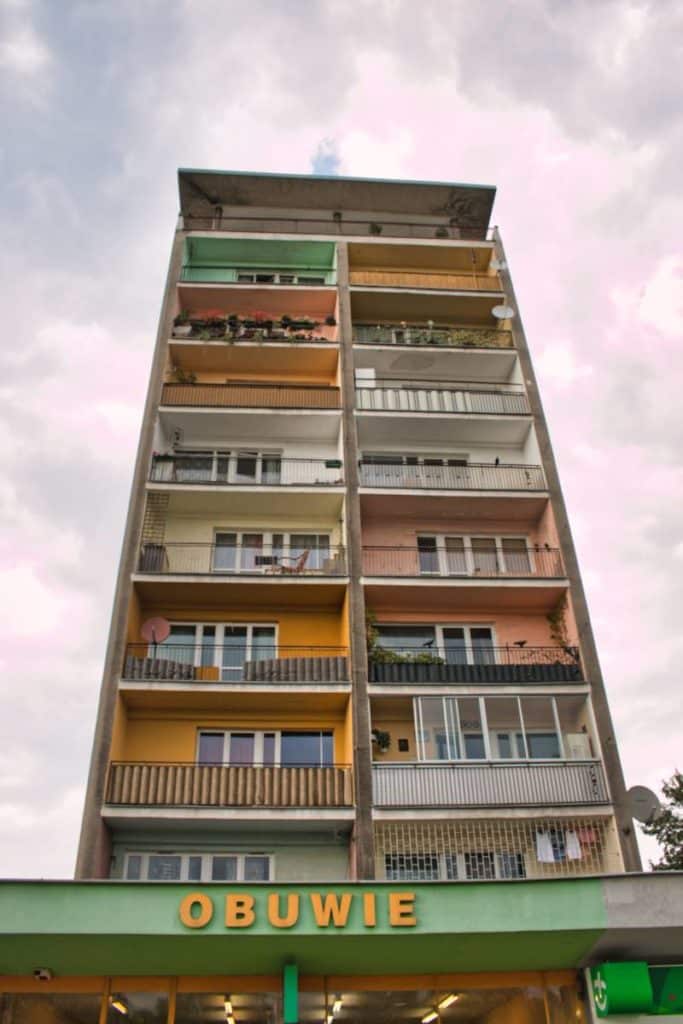
French block
Near the Swedish Block, another large residential unit was built. The 74-meter-long building is the first factory-built structure in Krakow and, just like the Swedish Block, features a combination of residential and commercial areas. Even today, the French Block is very popular. It also seems to have aged better than the Swedish Block, where the different color scheme of the facade as a whole seems somewhat “out of round” today. The French Block, on the other hand, has successfully made the leap into the present after extensive renovation and is in no way inferior to contemporary residential units.
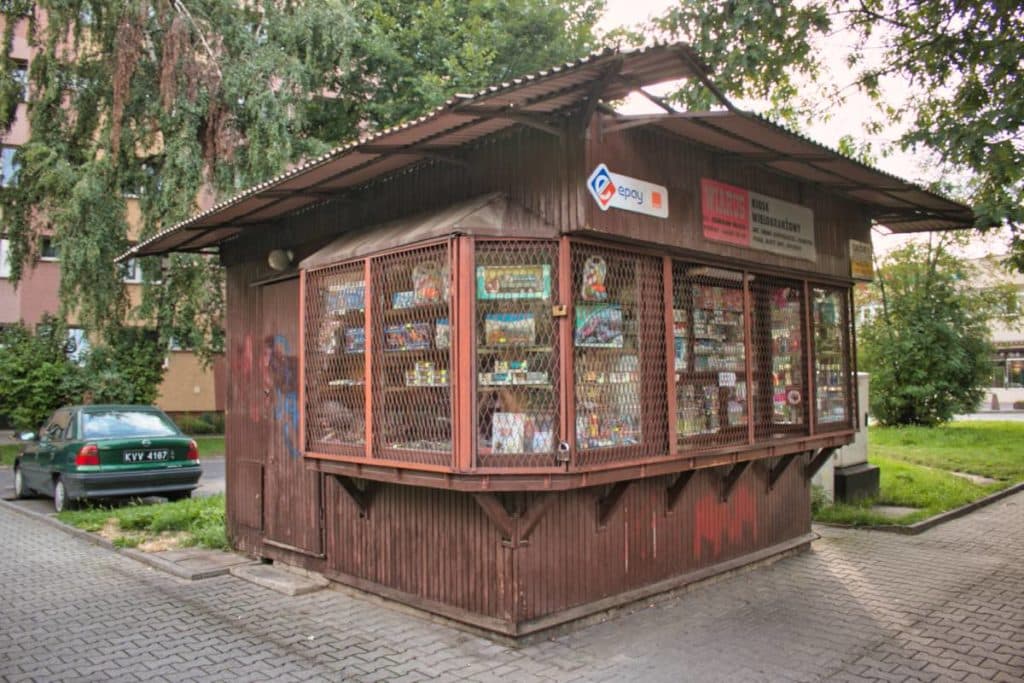
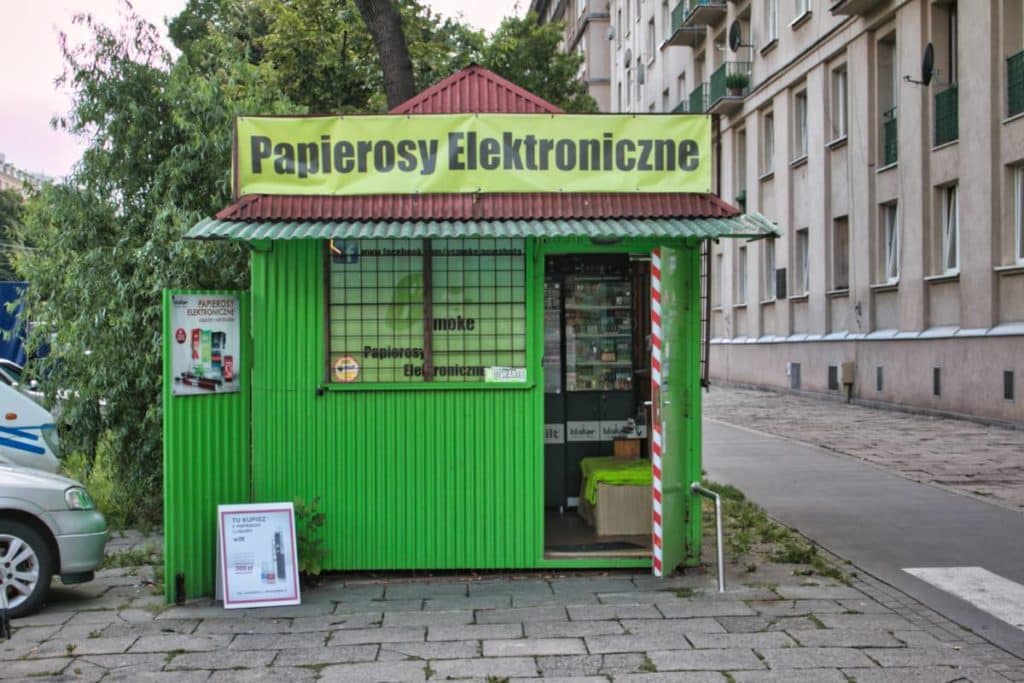

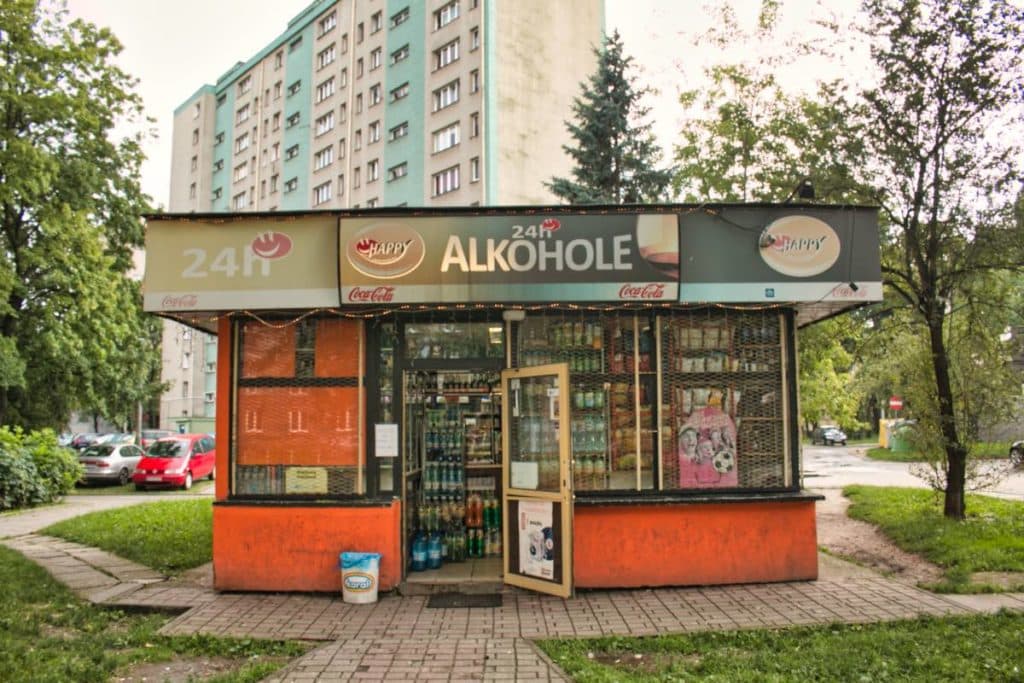
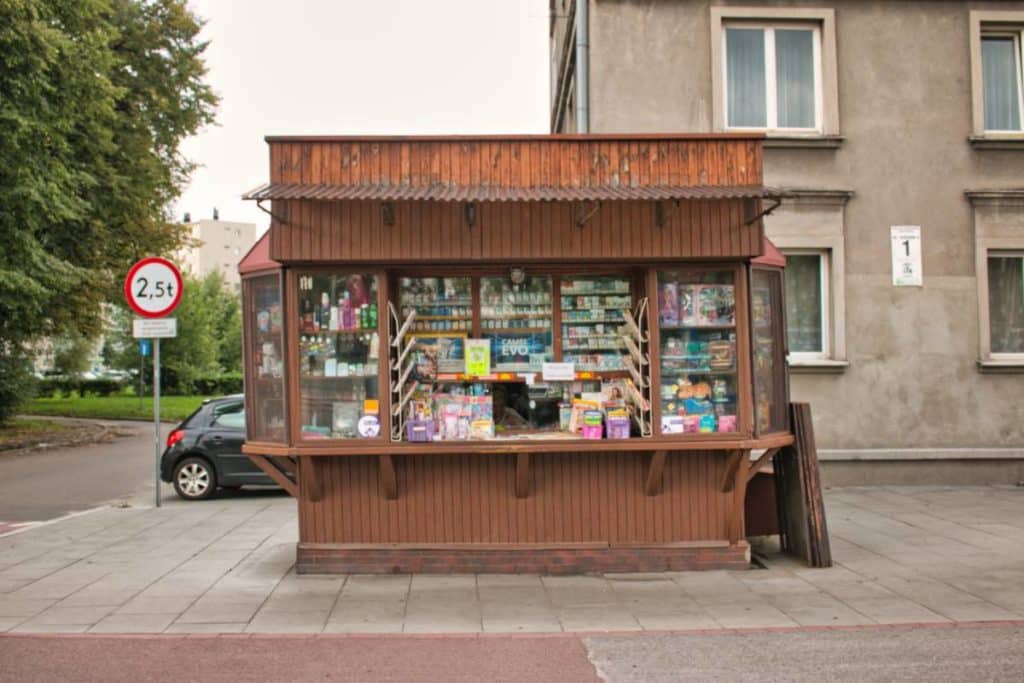
The kiosks of Nowa Huta
One of the most beautiful photo motifs in the Eastern Bloc countries are always the kiosks. The small local supply centers often still serve as sales stands for newspapers and cigarettes. Sometimes, however, they have already been converted, serve new purposes or stand empty. Their purpose in Nowa Huta also depends on their location and the needs of the customers. But they are also part of the history of Nowa Huta, being mostly as old as the whole neighborhood.
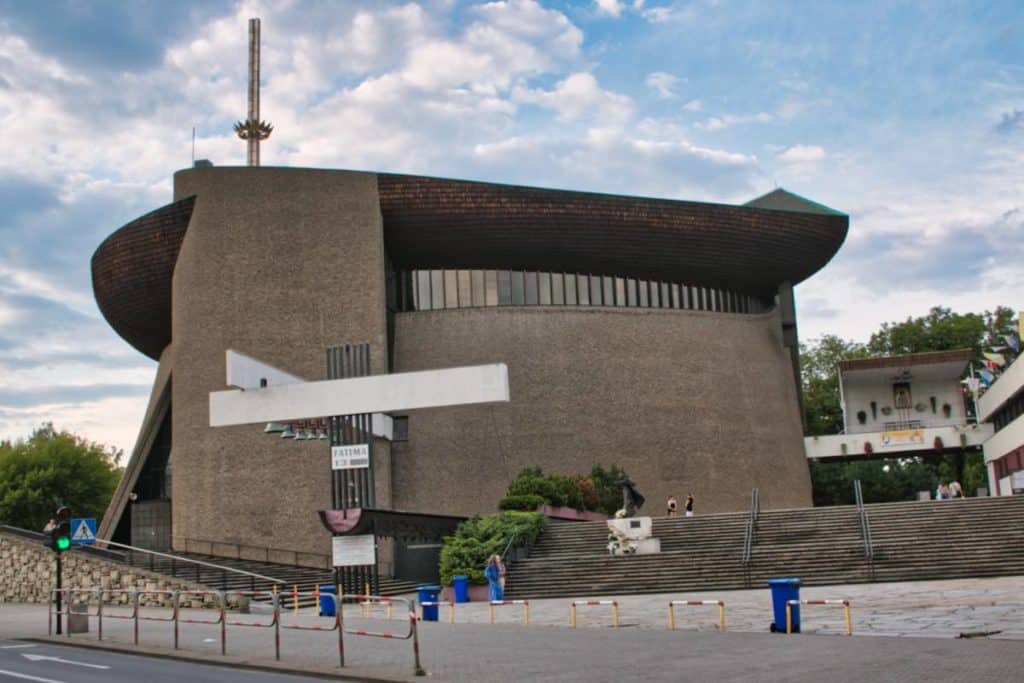
The Lord’s Ark
There is no church in Poland for whose construction the population had to fight as hard as for the Lord’s Ark in Nowa Huta. The communist rulers wanted to avoid at all costs the construction of a place of worship in their ideal socialist city. Until then, the faithful had to pray in secret or visit one of the village churches in the surrounding countryside. Nevertheless, some brave people managed to erect a cross at first, around which bloody fights broke out. In the end, however, the communist government had to bow to the will of the population and in 1969 the then Archbishop Karol Wojtyła laid the foundation stone.

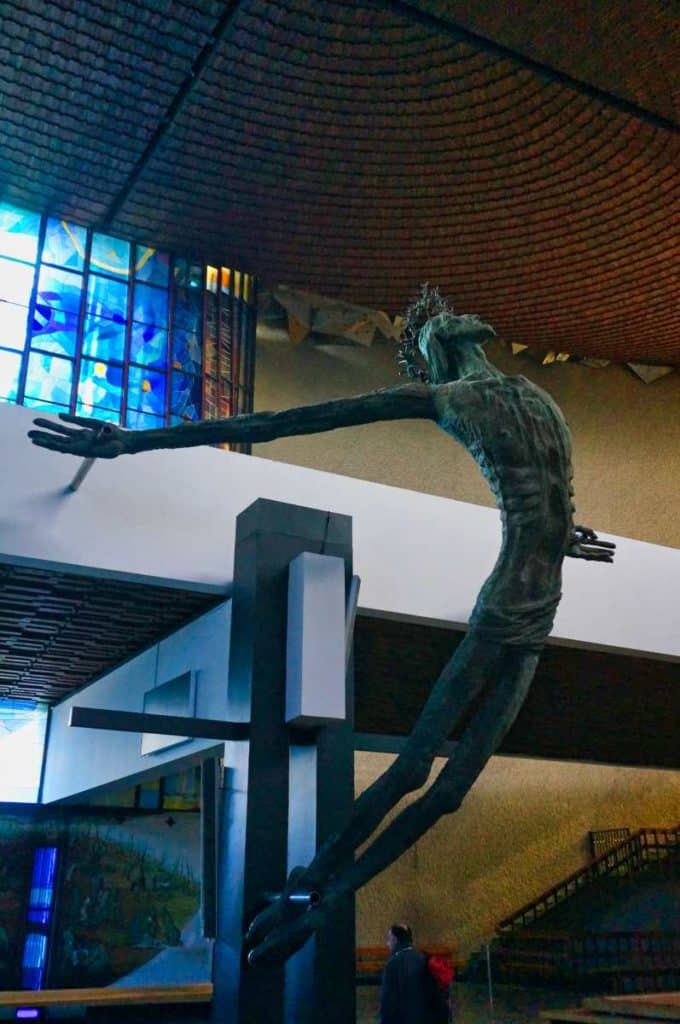
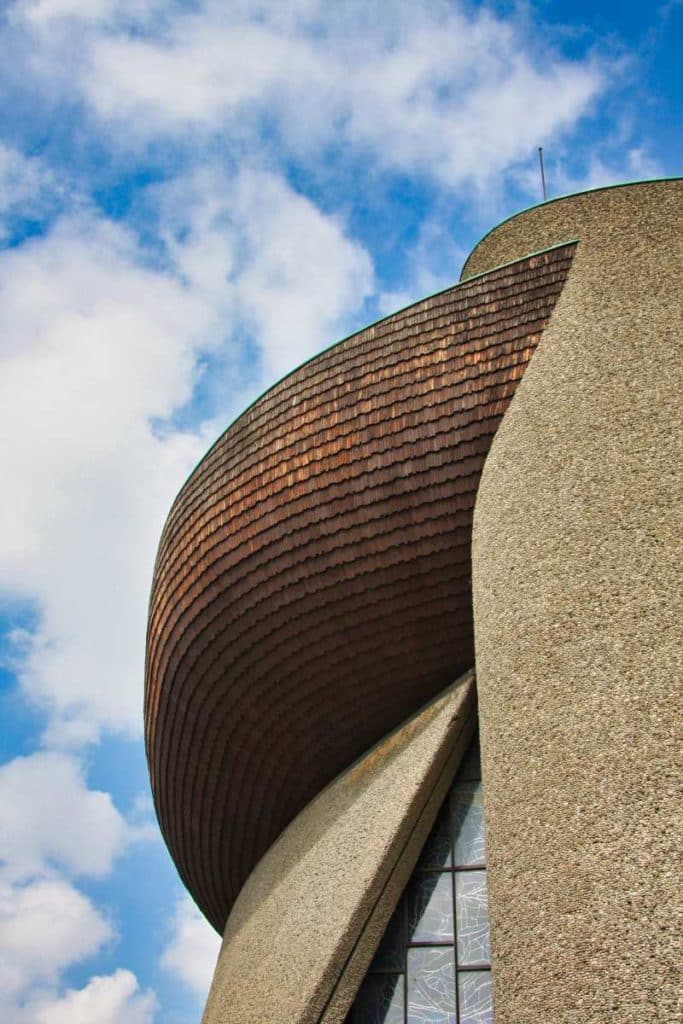
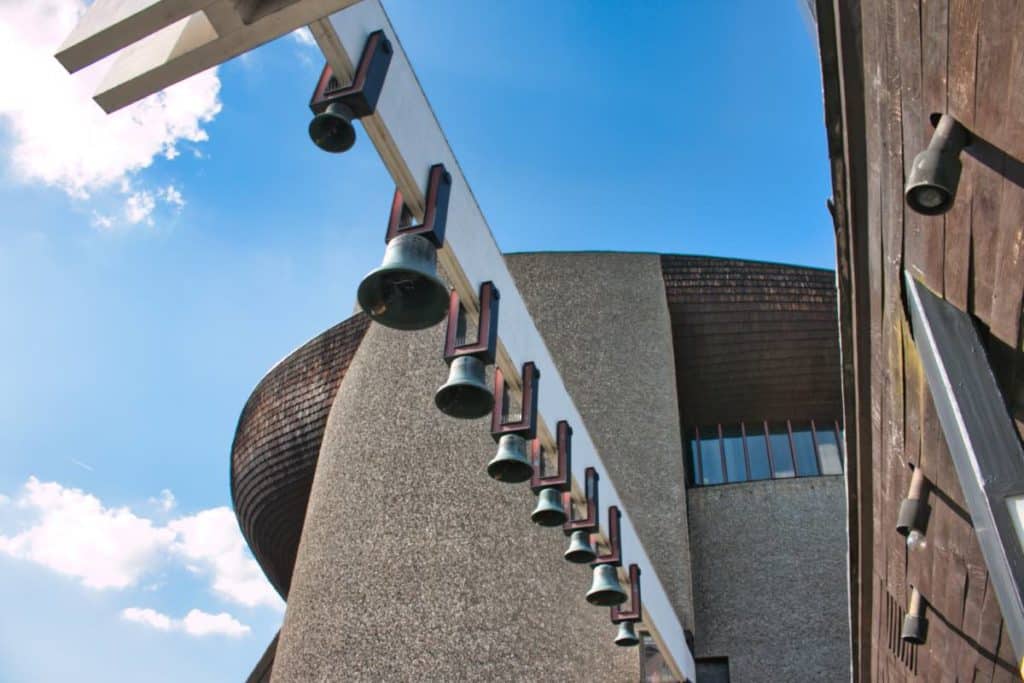
The building, realized by Wojciech Pietrzyk in the following years, is inspired by Le Corbusier’s Notre-Dame-du-Haut de Ronchamp and is characterized by a high mast with a golden crown placed in its center. The entire building is full of Christian symbolism, exemplified by the figure of Christ trying with all his might to break away from the cross – a clear sign that the people were trying to break away from communism.
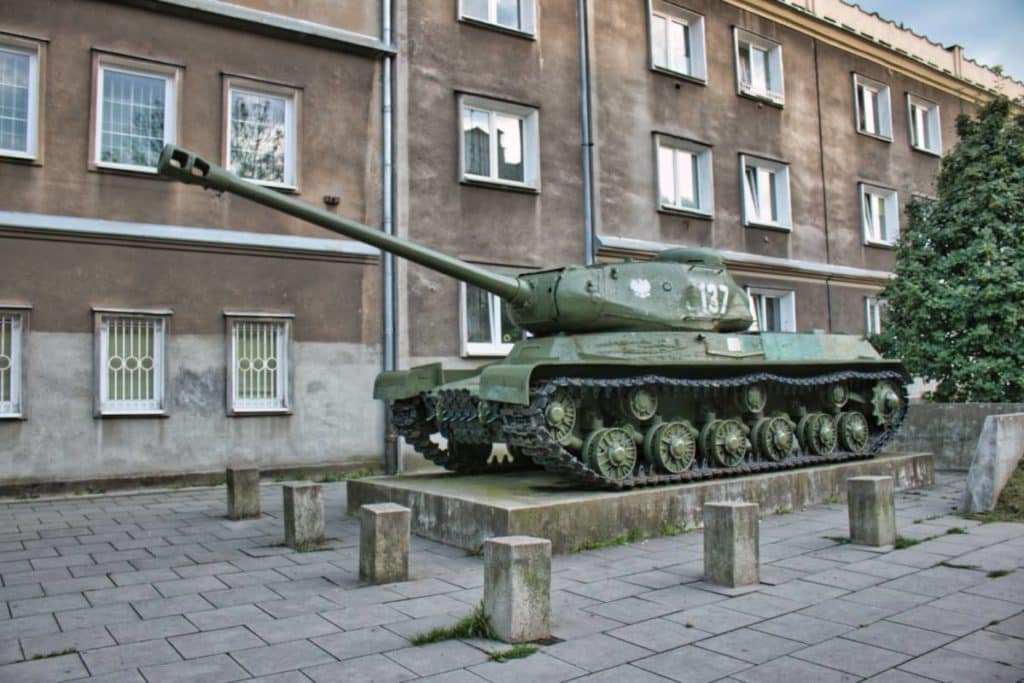
Museum of the Armed action
The roots of the “Museum of Armed Action” (Muzeum Czynu Zbrojowegu) in Nowa Huta go back to the 1960s, when an exhibition entitled “The Workers of Lenin’s Ironworks in the Struggle for People’s Poland” was shown. On display were exhibits from several uprisings (including non-socialist ones). Over time, the collection grew to several 1000 exhibits. In front of the museum there is a not-to-be-missed Soviet IS-2 tank, which, among other things, took part in the conquest of Berlin and Görlitz in World War II.
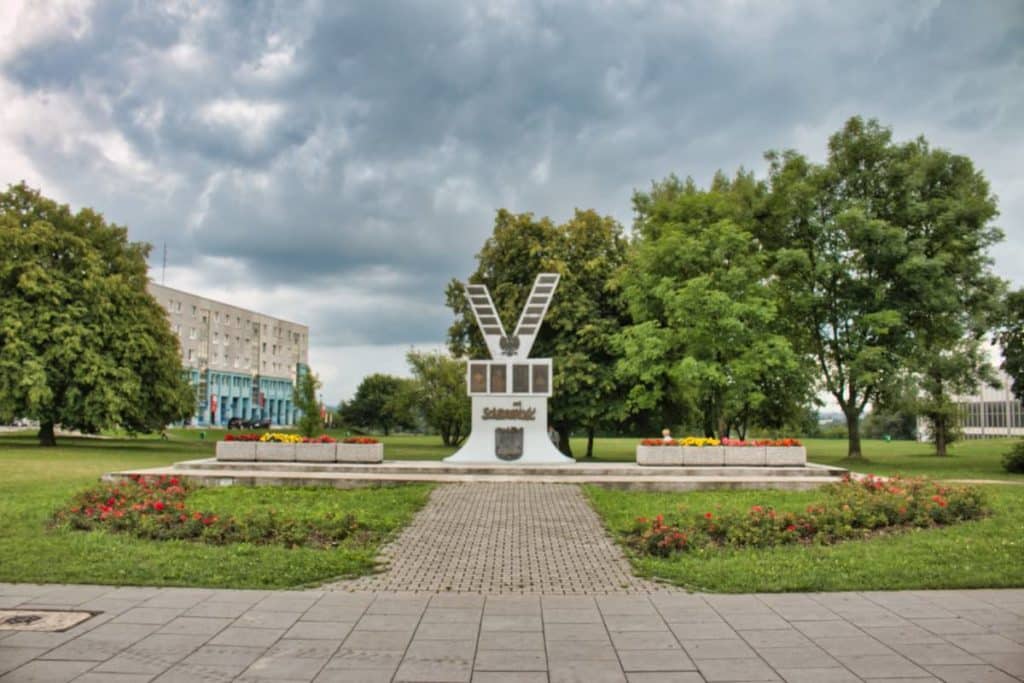
Monument to Solidarność
It must have come as a shock to the Polish comrades that a Solidarność strike committee was founded in the city of the “New Heople” in 1988. It turned out that even the model citizens, who were especially supported by the communists, had turned away from the communist system. Therefore, to commemorate the union and its achievements, a monument to Solidarność was erected in front of the Nowa Huta rolling mill in 1999. In 2005 it was moved to the Reagan Square, where it still stands today.

Cultural Centre Nowa Huta
A beautiful contrast to the otherwise gray buildings in the style of Realism is the Nowa Huta Cultural Center. The modernist building was completed in 1983 according to the plans of architect Zbigniew Pawelski and was to become the central cultural hall of Nowa Huta. Today, several cultural ensembles are based here. Since 2016, the cultural center has also housed a gallery with 250 works by Zdzisław Beksiński, whom some call the Polish HR Giger. However, that is a bit too rough a description for the work of this master.
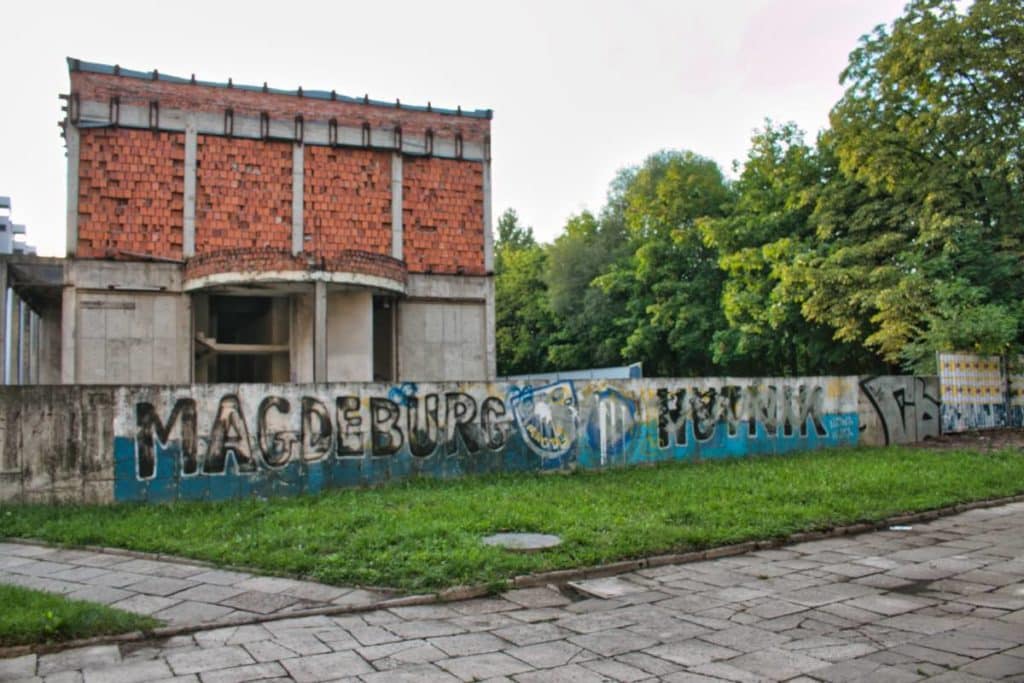
Soccer Club Hutnik Krakow Nowa Huta
Most soccer fans probably know the two teams Wisła and Cracovia. However, only a few know the name of the third Krakow team Hutnik Krakow. In the past, the team was simply called Hutnik Nowa Huta. Unfortunately, the club plays only in the third Polish league and therefore rarely meets the other big clubs. However, this is a fate that the club shares with 1. FC Magdeburg. The fans of the team even maintain a fan friendship with the latter. That’s why there’s also a tribute to the only European Cup winner from the former GDR on one or the other wall in Nowa Huta.
Food and drinks in Nowa Huta
You can eat and drink very well everywhere in Krakow. And even though there are good restaurants even in Nowa Huta, we want to introduce you to places that are related to the history of the district.
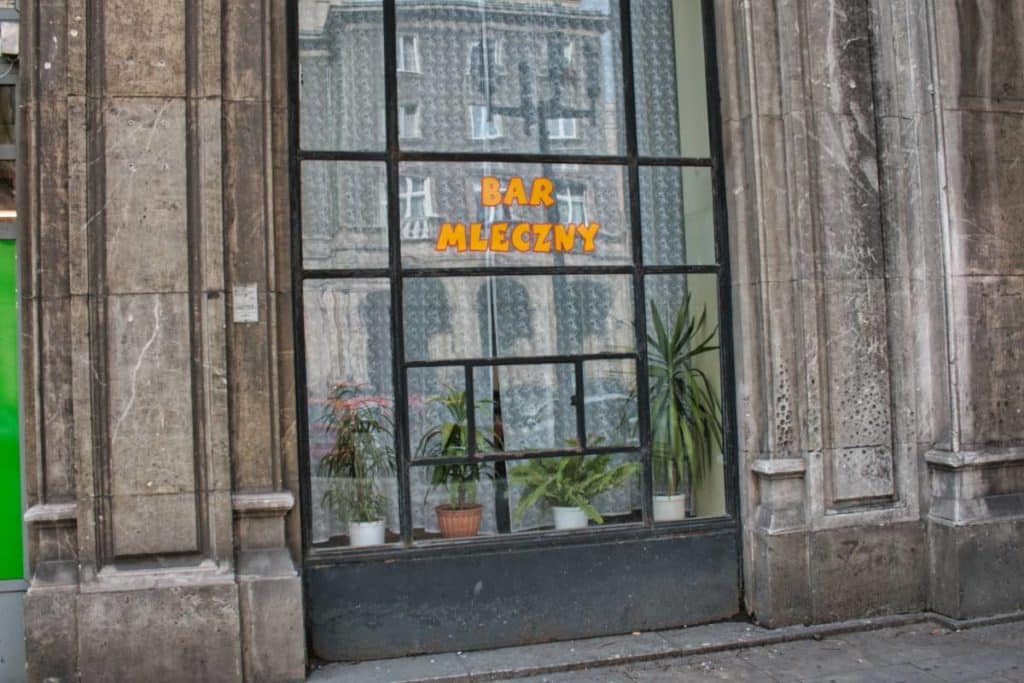
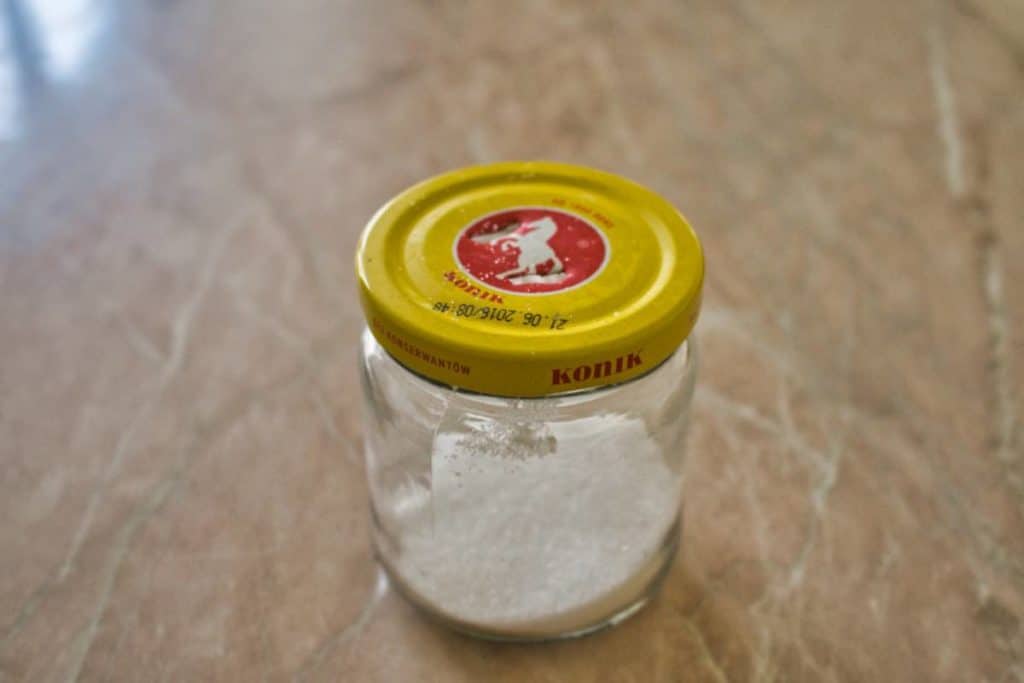
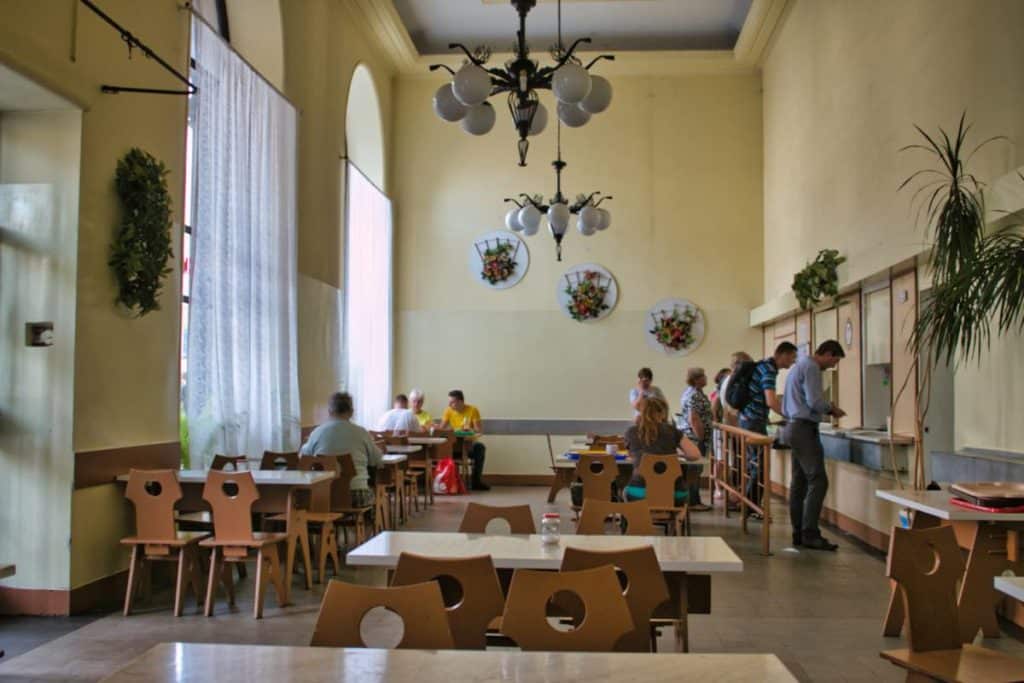

Bar Mleczny Centralny
A visit to Nowa Huta simply includes a Polish meal at the Mleczny Centralny bar. Here all classes of the population eat and there is delicious food of the Polish cuisine at reasonable prices. What exactly a milk bar is, you will learn in this article. The Bar Mleczny Centralny is also a particularly beautiful and nostalgic example, where no frills are used and as a salt shaker simply a jar with holes in the lid is used. Delightful! Address: Osiedle Centrum C 1, Kraków
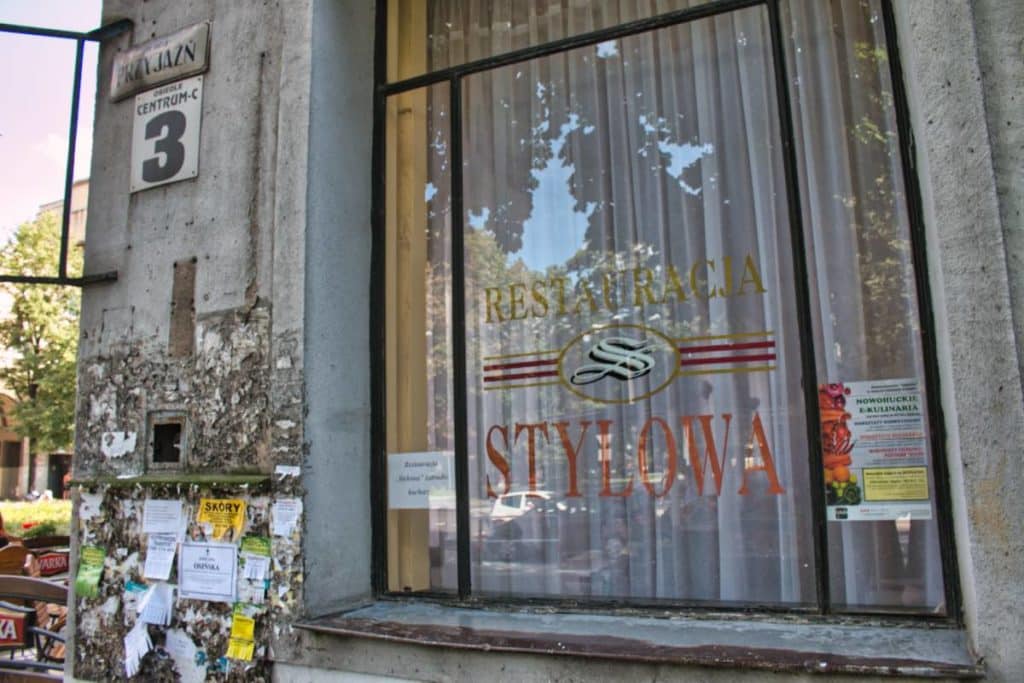
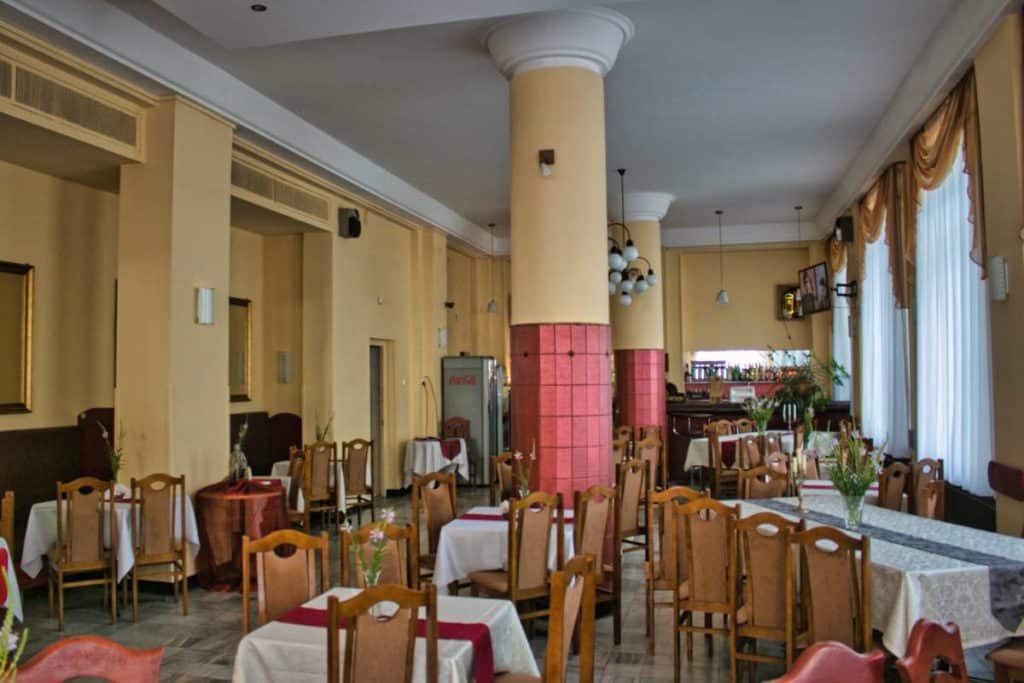
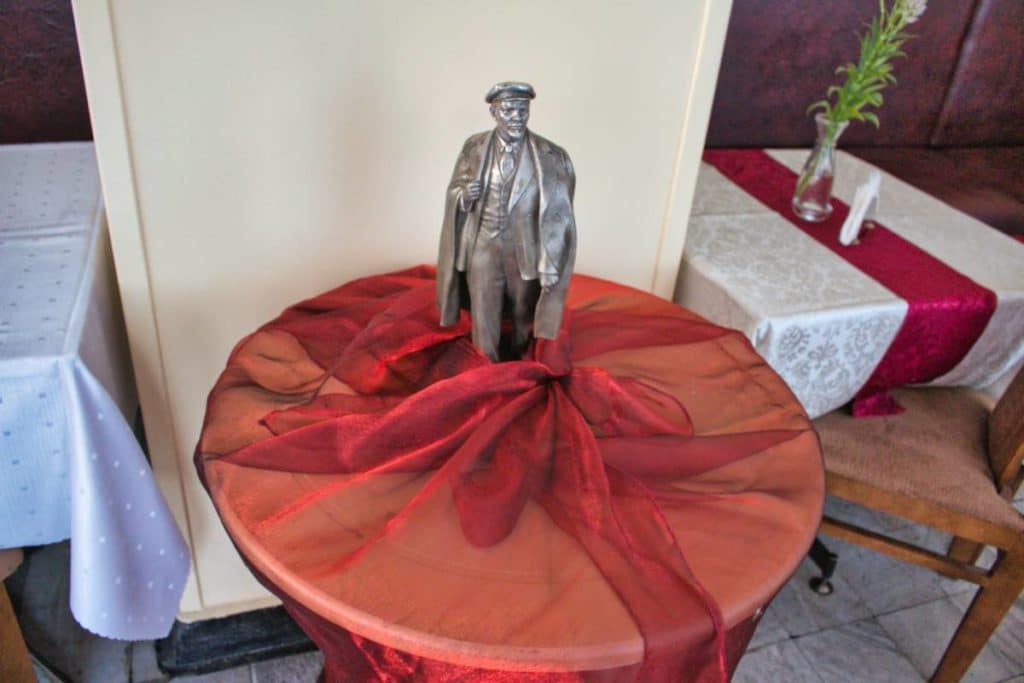
Restaurant Stylowa
The Stylowa Restaurant also still exudes the charm of the People’s Republic of Poland, as far as you can call it that. The interior looks as if the brigade celebrations of the metallurgists still take place here. Built in 1953 to 1955, the Stylowa was the most elegant restaurant in Nowa Huta, along with the now-defunct Arkadia. Especially the chandeliers from the period of socialist realism and a miniature Lenin remind of the history of the place. After all, Lenin stood only a few meters from the restaurant. This is a great place to toast and discuss Nowa Huta. However, in the times of the People’s Republic it was not a place where vodka was drunk. Bulgarian wines and cognac were served here. Address: Osiedle Centrum C 3, Kraków
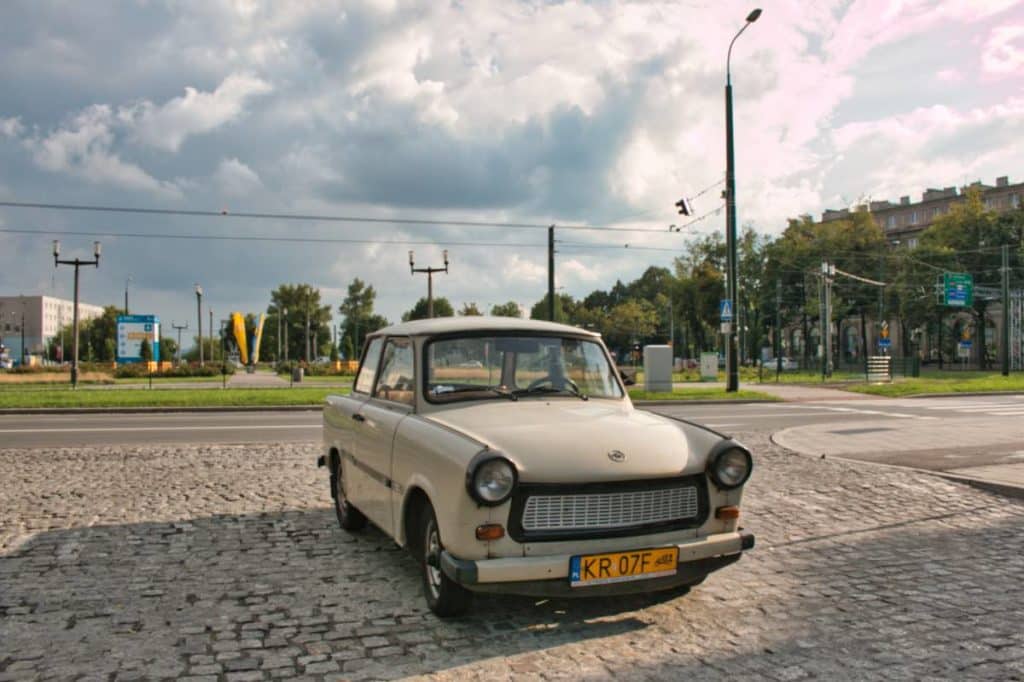
Nowa Huta Tours
One of the best ways to get authentic information about Nowa Huta in a short time is to take a tour of Nowa Huta. We also took one for research purposes and found it very entertaining. The first operator to offer tours of communist Krakow and to Nowa Huta was Crazy Tours Krakow. They still offer these tours today.
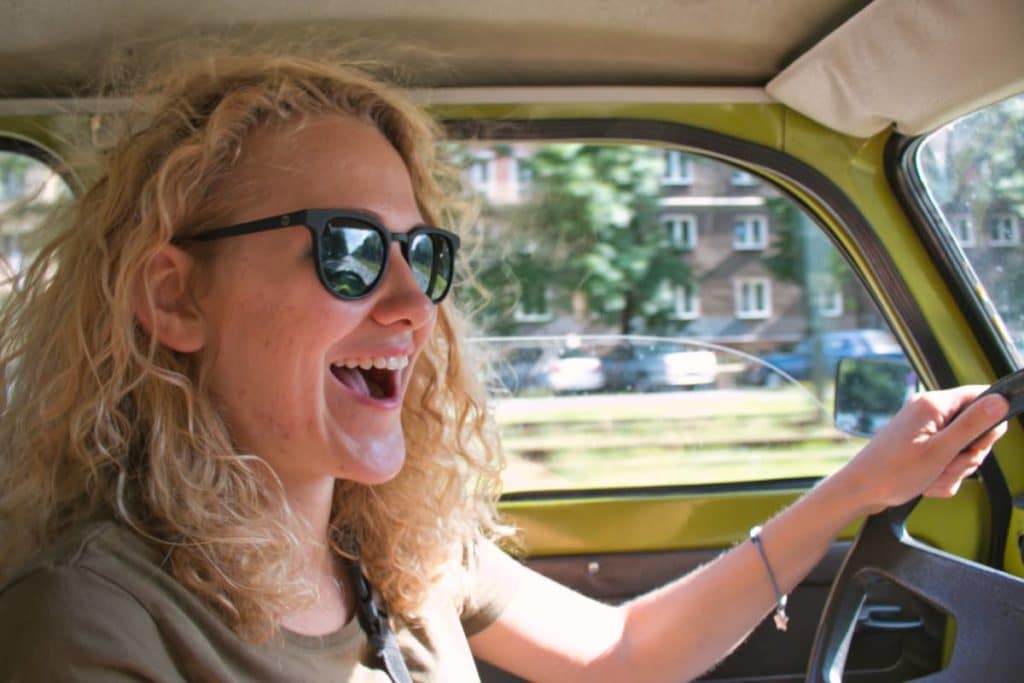
We were picked up by our guide in a Trabant and driven around. On the way there were many useful anecdotes. You can easily book the tours online. There are 2 tours from the provider:
- 2.5 hours tour* through Nowa Huta with a city guide and pick up from the accommodation by a East German “Trabi”
- 4 Hours Premium Tour* through Nowa Huta and communist Krakow with a city guide, including pick-up in a Trabi from your accommodation
We did the longer tour and can only recommend it. Friendly and entertaining guides who can tell you a lot and also had good tips for the evening activities.
Book recommendations about Nowa Huta Krakow
This book does not only focus on the buildings, but rather on the people living in this amazing district
- Markus Bingel (Author)
A book about the history of Nowa Huta Krakow, that describes the first years of the Communist model city in a great way!
How did you like our trip to Nowa Huta Krakow? Feel free to let us know and write us a comment here. We are always happy to receive suggestions for new topics! Feel free to follow us on Facebook and stay up to date about new posts.

